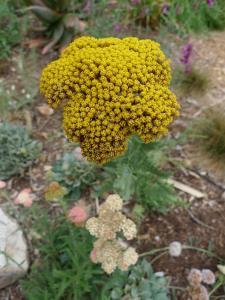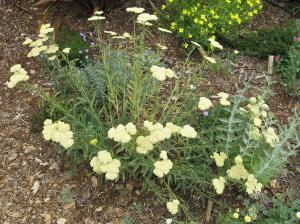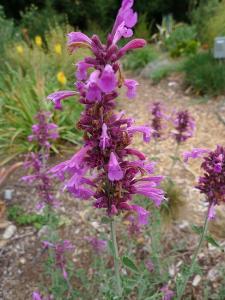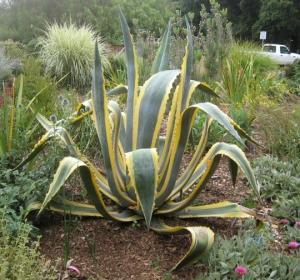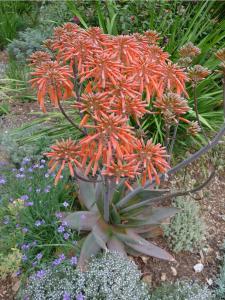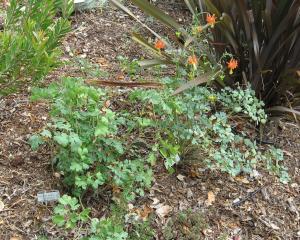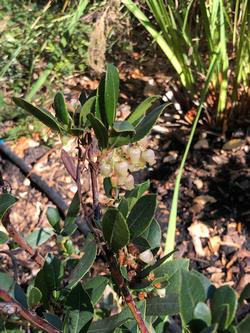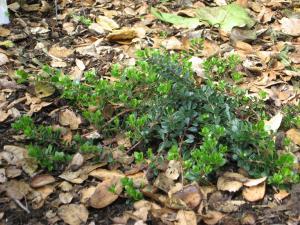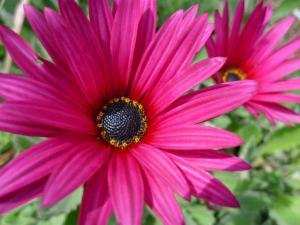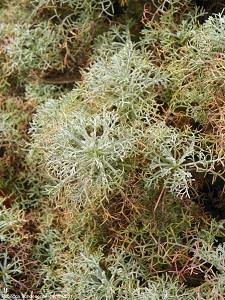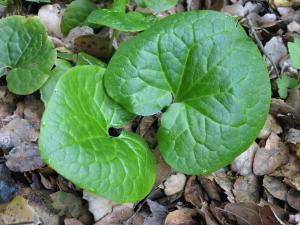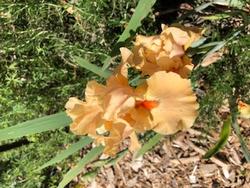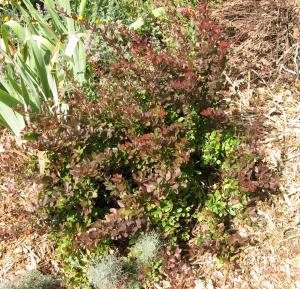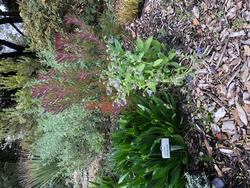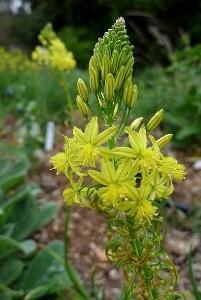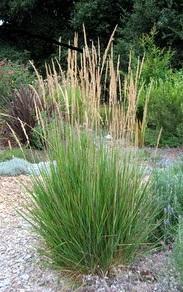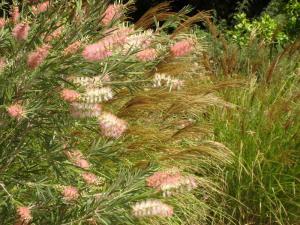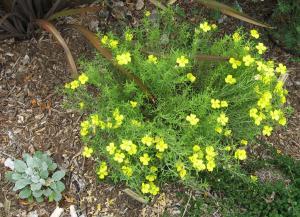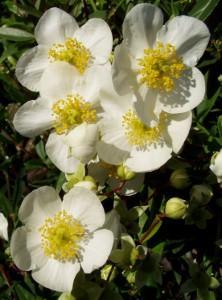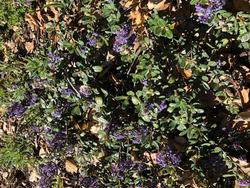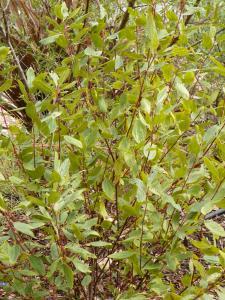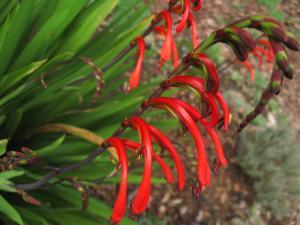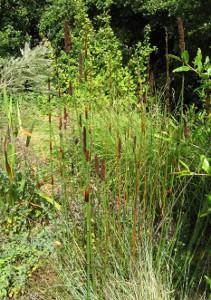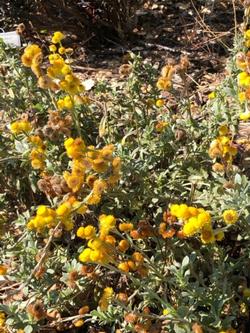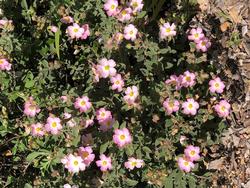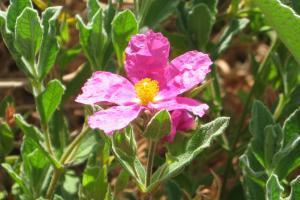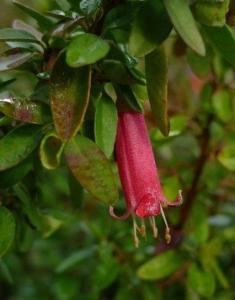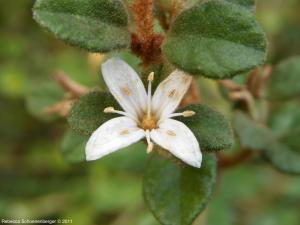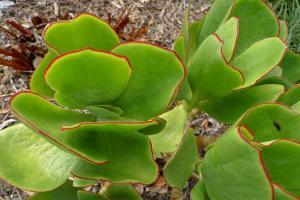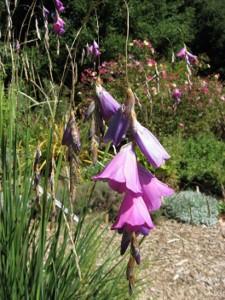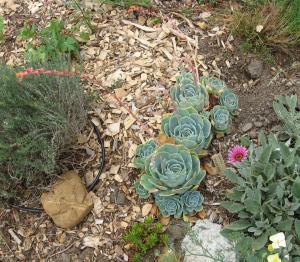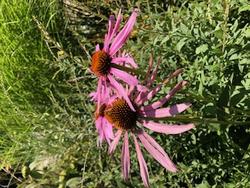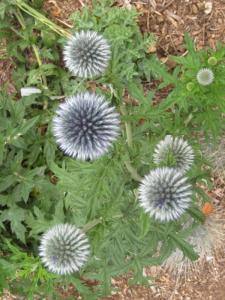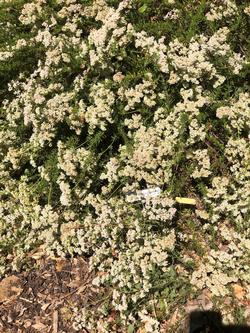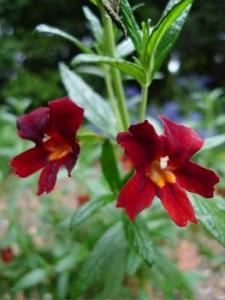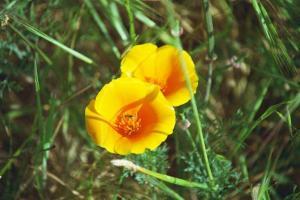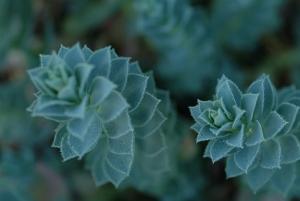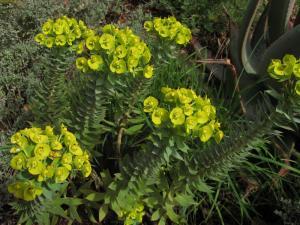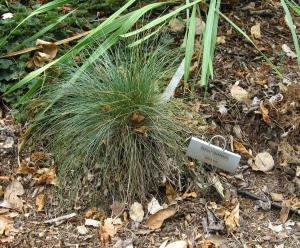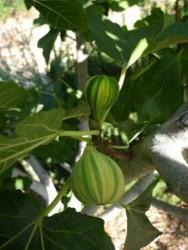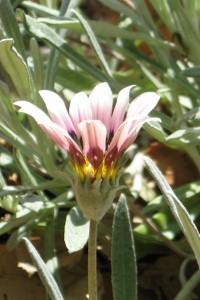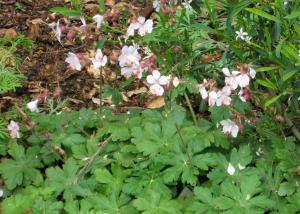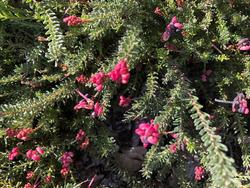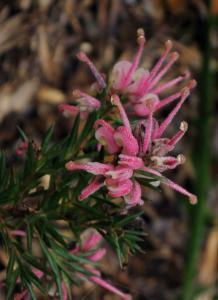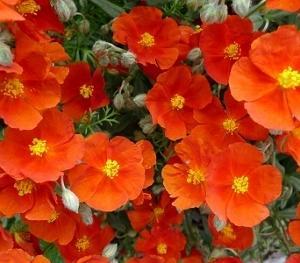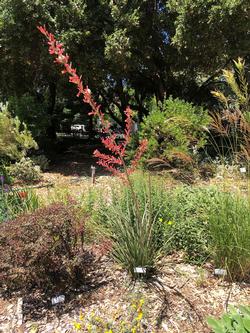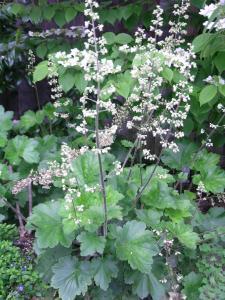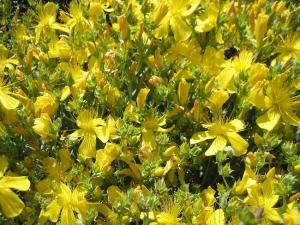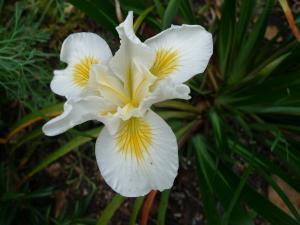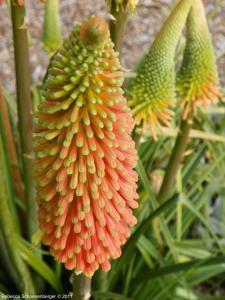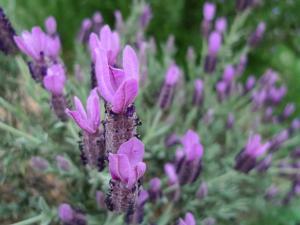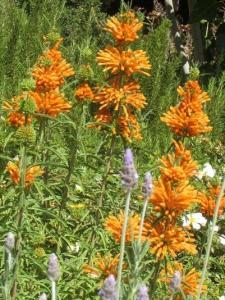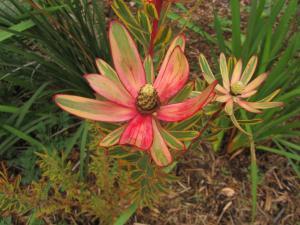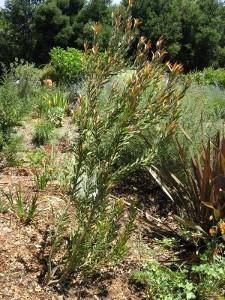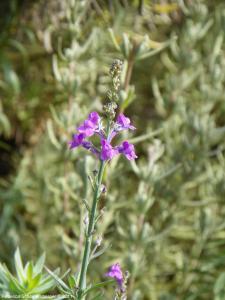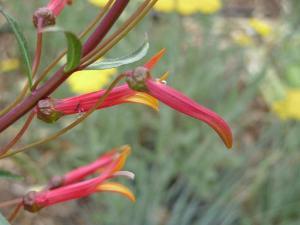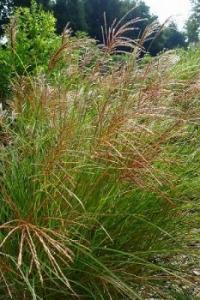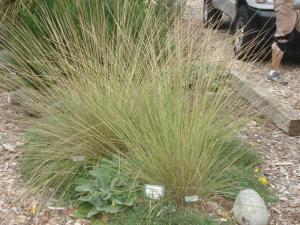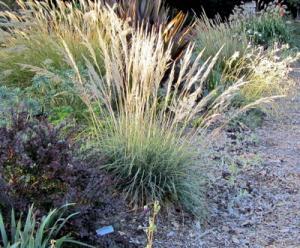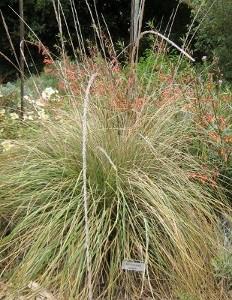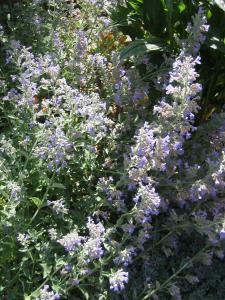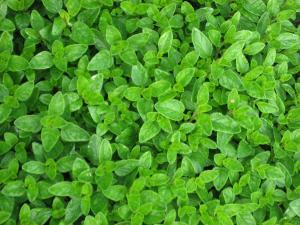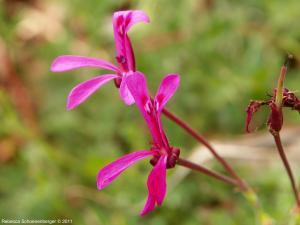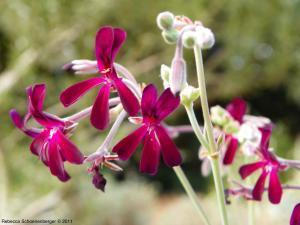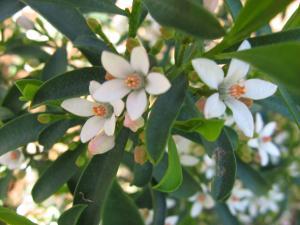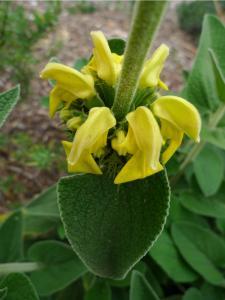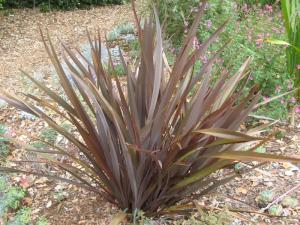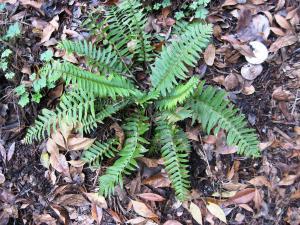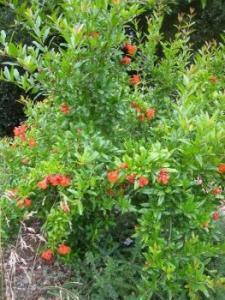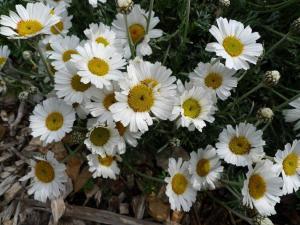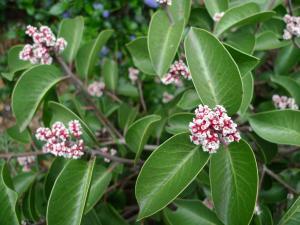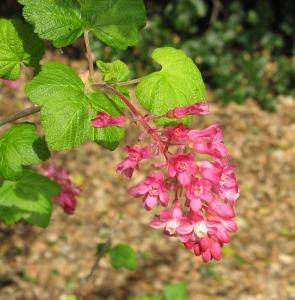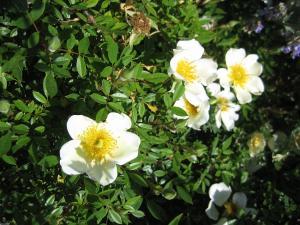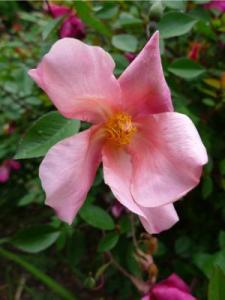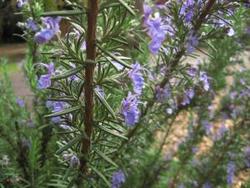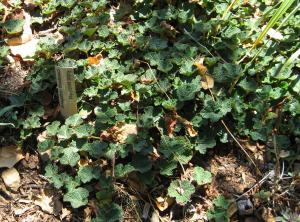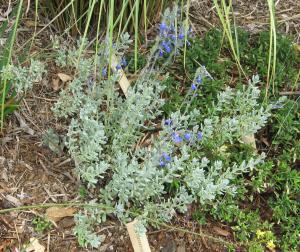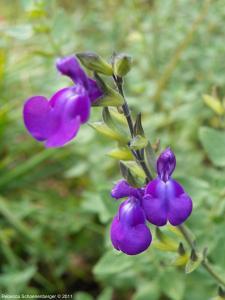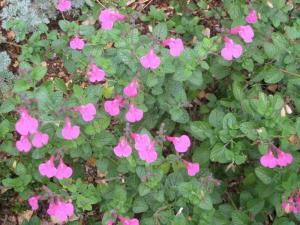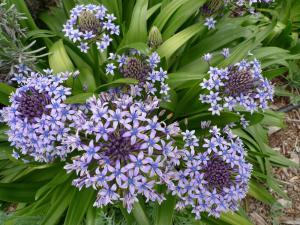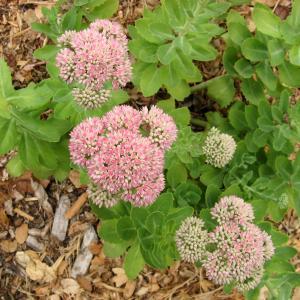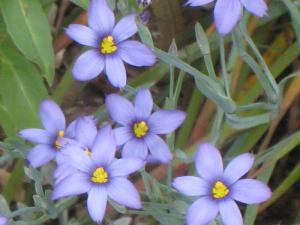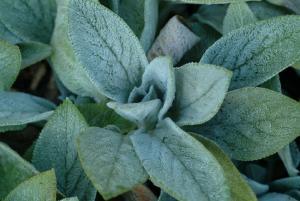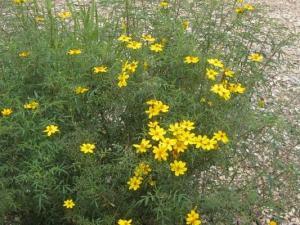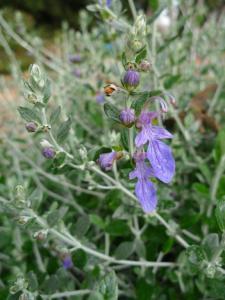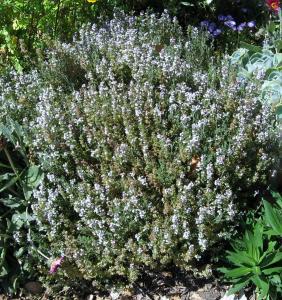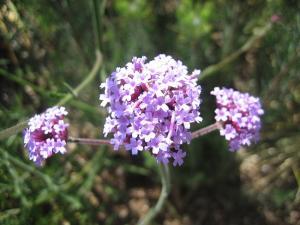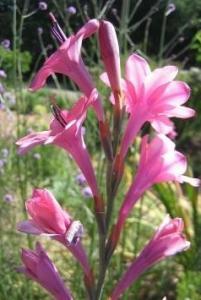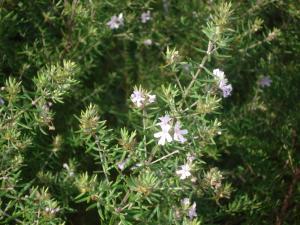Water Wise Plants
Here's a full list of all our water wise plants. You can also view an image gallery, or view the plants by categories.
Achillea ‘Moonshine’
Pronunciation
ah-KILL-lee-ah
Common Name
Yarrow ‘Moonshine’
Plant Type
Perennial
Mature Size
2 ft.
Water Requirements
Low: water every three weeks until the root ball is wet
Sun/Shade Requirements
Full sun
Wildlife
Flower Color
Bright yellow
Where to See
Maintenance- Design- Planting Tips
Achillea ‘Moonshine’ is a reliable mid-summer bloomer whose deep yellow flowers will stand out in a garden. Requiring very little maintenance, these plants are a magnet for butterflies and beneficial insects. The flowers have lots of nectar and the flat shape of the flower serves as a perfect landing pad for butterflies. Deadhead spent flowers to keep the plants looking fresh. Vigorous clumps can be divided in the winter. |
Achillea ‘Taygetea’
Pronunciation
ah-KILL-lee-ah tay-GET-ee-uh
Common Name
Yarrow ‘Taygetea’
Plant Type
Perennial
Mature Size
12 in. to 18 in. wide and tall
Water Requirements
Low: water every three weeks until the root ball is wet
Sun/Shade Requirements
Full sun
Wildlife
Flower Color
Creamy yellow
Where to See
Maintenance- Design- Planting Tips
‘Taygetea’ Greek yarrow is a cheerful, reliable summer bloomer. The flowers start out bright yellow in midsummer and fade to a more mellow shade over time. The grey-green foliage blends in well with many plants found in low water gardens. This cultivar of yarrow seems to be more drought tolerant than the popular Achillea millifolium.
Greek yarrow doesn't need a great deal of maintenance. To encourage reblooming, deadhead it regularly. This plant will spread, so don't plant it too tightly. |
Agastache
Pronunciation
ag-ah-STAK-ee
Common Name
Agastache
Plant Type
Perennial
Mature Size
3 ft. wide and 2 ft. tall
Water Requirements
Low: water every three weeks until the root ball is wet
Sun/Shade Requirements
Full sun
Wildlife
Flower Color
Pink
Where to See
Maintenance- Design- Planting Tips
Agastache are originally from the Southwest and Mexico, a climate that is somewhat different from Santa Clara County’s Mediterranean summer-dry climate. These plants require well-draining soil, but local soils tend to be slow-draining clay soils.
PADG notes: This unnamed cultivar of Agastache has been a mixed success in our gardens. |
Agave americana
Pronunciation
ah-GAH-vay ah-mer-ih-KAY-nah
Common Name
Century Plant
Plant Type
Succulent
Mature Size
6 ft. wide to 10 ft. high
Water Requirements
Low: water every three weeks until the root ball is wet
Sun/Shade Requirements
Full to half sun
Wildlife
Flower Color
Yellowish green flowers on 15 ft. to 20 ft. stalks
Where to See
Maintenance- Design- Planting Tips
This plant is quite the showstopper and makes a powerful statement when placed among grasses and softer, small-leaved perennials. Small plants form around the base of the plant, but they are easily pruned out if desired.
PADG notes: To prevent accidental injuries, we prune off the sharp spiky tips of this plant. |
Aloe striata
Pronunciation
AL-oh stree-AH-tuh
Common Name
Coral Aloe
Plant Type
Succulent
Mature Size
2 ft. to 3 ft. tall and 1 ft. to 2 ft. wide
Water Requirements
Low: water every three weeks until the root ball is wet
Sun/Shade Requirements
Full sun
Wildlife
Flower Color
Red-orange
Where to See
Maintenance- Design- Planting Tips
Like many succulents, Aloes are from South Africa. Aloe striata tolerates cold better than most aloes and grows successfully in the Bay Area. The large, broad, fleshy leaves and tall clusters of flowers are bold additions to the summer-dry perennial bed. As a bonus, hummingbirds and bees are attracted to its orange-red blossoms.
The only maintenance this plant needs is to cut back the inflorescence after the flowers have dropped off. Aloe striata is also easy to propagate. Remove the pups (baby plants) from the base of the plant, let the stems dry and harden, and then plant the cuttings in a pot of cactus soil mix. |
Aquilegia eximia
Pronunciation
ak-will-EE-jah Eks-IM-mee-uh
Common Name
Serpentine Columbine
Plant Type
Perennial
Mature Size
5 ft. high and 1.5 ft. wide
Water Requirements
Low: water every three weeks until the root ball is wet
Sun/Shade Requirements
Half sun
Wildlife
Flower Color
Yellow and orange
Where to See
Maintenance- Design- Planting Tips
Columbines are great plants for woodland areas. Their blooms are delicate and lovely. In the summer, the foliage tends to die back. Aquilegia eximia, a California native, is a UC Davis Arboretum All-Star plant.
PADG notes: Our Aquilegia eximia planted in partial sun hasn't done as well as we would like. We are trying it in a shady spot. The plant may need more water than our water wise garden is given. |
Arbutus unedo ‘Compacta’
Pronunciation
ar-BYOO-tus YOO-nee-doe
Common Name
Strawberry Bush
Plant Type
Tree
Mature Size
10' high x 10' wide
Water Requirements
Low: water every three weeks until the root ball is wet
Sun/Shade Requirements
Full to half sun
Wildlife
Flower Color
White
Where to See
Maintenance- Design- Planting Tips
Arbutus uneda or Strawberry Tree is a small tree with dark green leaves. It has dainty, white, bell-shaped flowers in the fall and winter. The flowers are followed by small, bright red fruits that somewhat resemble a strawberry. The fruit is enjoyed by birds and although not toxic to humans, they are not considered tasty. The fruit can be messy if the tree planted over sidewalks or patios. PADG notes: The tree was planted at PADG in 2020. It is currently doing well and is drip irrigated every two weeks during the dry season. As it matures it will need less water. |
Arctostaphylos ‘Emerald Carpet’
Pronunciation
ark-toe-STAF-il-lohs
Common Name
Manzanita ‘Emerald Carpet’
Plant Type
Groundcover
Mature Size
5 ft. wide and 8-14 in. tall
Water Requirements
Low: water every three weeks until the root ball is wet
Sun/Shade Requirements
Full to half sun
Wildlife
Flower Color
Pink flowers
Where to See
Maintenance- Design- Planting Tips
‘Emerald Carpet’ is a slow growing California native manzanita from the coast of Mendocino County. It is a very attractive plant with dark glossy leaves, reddish stems and small flowers in the early spring. There are many different cultivars of manzanita, ranging from ground covers to small trees. Manzanitas are a good wildlife plant and typically are a hearty plant. They do well in very dry situations. Most manzanitas need superb drainage, or they will struggle and die. Plant on a mound or slope and water weekly for the first summer and less after that. By the third summer, stop watering. Avoid fertilizing the plant. These plants rarely need pruning. Remove the odd branch that dies back in the late summer and the plant will fill in. Some gardeners will remove the lower branches on some of the larger manzanitas to highlight the interesting branching structure and reddish bark. Some Santa Clara Master Gardeners have had success using the cultivar ‘Carmel Sur’ as a ground cover in low-water landscapes. PADG notes: ‘Emerald Carpet’ has not thrived at PADG. It may need more water than most manzanitas. |
Arctotis ‘Purple Torch’
Pronunciation
ark-TOE-tiss
Common Name
African Daisy
Plant Type
Perennial
Mature Size
1 ft. to 1 1/2 ft. tall and wide
Water Requirements
Low: water every three weeks until the root ball is wet
Sun/Shade Requirements
Full sun
Wildlife
Flower Color
Purple
Where to See
Maintenance- Design- Planting Tips
Arctotis ‘Purple Torch’ is a low growing ground cover with gray felty leaves that are attractive even when there are no flowers. It begins blooming in the winter and continues until the weather gets hot. Other varieties of African daisy will bloom through the summer.
To keep Arctotis looking its best, the flowers should be regularly deadheaded when past their prime, and the plant should be replaced every few years. Cuttings root easily in the cool months. PADG notes: The Palo Alto Demonstration garden has planted ‘Purple Torch’ throughout the beds to unify the garden. It combines well with Bulbine frutescens, which blooms at approximately the same time. |
Artemisia versicolor ‘Seafoam’
Pronunciation
ar-te-MIZ-ee-uh VER-suh-kuh-lor
Common Name
Artemisia versicolor ‘Seafoam’
Plant Type
Groundcover
Mature Size
6 - 12 in. high can spread 15 - 18 in.
Water Requirements
Low: water every three weeks until the root ball is wet
Sun/Shade Requirements
Full to half sun
Wildlife
Flower Color
Yellow and orange
Where to See
Maintenance- Design- Planting Tips
The leaves of Artemisia ‘Seafoam’ are silver and frilly, which add a nice texture to the garden. It is a short-lived perennial that needs to be replanted after several years. The plant wants to bloom, but unfortunately will die back afterwards. To prevent the die back, cut off the yellow flowers.
PADG notes: ‘Seafoam’ has been used as a small edging plant in the Demonstration Garden. We have repeated silver foliage plants around the edge of the garden beds as a way of tying different beds together. But we find cutting off the flowers to keep the plant looking good to be labor intensive. |
Asarum caudatum
Pronunciation
ah-SAR-um kaw-DAH-tum
Common Name
Wild Ginger
Plant Type
Groundcover
Mature Size
7-10 inches high and spreading
Water Requirements
Low: water every three weeks until the root ball is wet
Sun/Shade Requirements
Shade
Wildlife
Flower Color
Maroon, generally hidden by leaves
Where to See
Maintenance- Design- Planting Tips
This California native boasts large, shiny, heart-shaped leaves that give the plant a lush, almost tropical look. The leaves can be up to seven inches wide, which can hide the interesting maroon flowers that bloom in late winter or early spring. Asarum caudatum grows naturally in the coastal redwood forests and prefers a cool, moist environment. In Santa Clara County gardens with coastal influences, wild ginger can do well on a low water diet if given a shady spot and rich soil full of organic material. In drier landscapes, it may disappear in the summer months and reappear after the winter rains. This plant is extremely low maintenance. All it seems to need is the occasional removal of old leaves. |
Bearded Iris
Pronunciation
Common Name
Bearded Iris
Plant Type
Bulb
Mature Size
1.5 to 4 feet high Spreads via rhizomes
Water Requirements
Low: water every three weeks until the root ball is wet
Sun/Shade Requirements
Full to half sun
Wildlife
Flower Color
Many colors except true red and green,
Where to See
Maintenance- Design- Planting Tips
Bearded irises are beloved for their showy spring flowers, structurally pleasing upright, green leaves and low, summer water needs. They come in a wide range of colors and shapes. Choosing a mix of early, mid and late bloomers prolongs the spring bloom period, and the addition of re-blooming varieties gives another flush of flowers in the fall and winter season. Unfortunately, re-blooming varieties do need water year-round to re-bloom, and the second bloom has fewer flowers. All bearded irises need full sun for at least half the day to bloom well.
Given enough water from late fall through spring, intermediate bearded iris can grow to a height of 2.5 feet tall, and tall bearded iris can reach 4 feet in height. With enough water they develop tall flower stalks supporting numerous large blooms. With less water during the growing season, the plants are smaller with fewer flowers, but the blooms are still striking. Improve growth by adding compost and mulch in the fall, which helps retain soil moisture and provides nutrients for better bloom. Allow plant leaves and soil to dry out between watering to prevent fungal infections and flower loss. During the summer, bearded irises are dormant, and their leaves die back. For aesthetics many people cut the leaves back when they begin to yellow, but it is not necessary. Plants remain healthy with and without summer trims. Be aware though, there is one major maintenance issue when growing bearded iris. These plants grow from thick rhizomes. Each year new rhizomes spread from the original making a larger clump. As the older rhizomes die, a dead spot will eventually appear in the center of the iris clump. To prevent this from happening and to keep clump size in check, divide iris rhizomes about every three years. Do this during the hot summer months when plants are dormant and fungal infections are less likely to affect the cuts from the mother rhizomes. |
Berberis thunbergii ‘Crimson Pigmy’
Pronunciation
BER-ber-is thun-BERG-ee-a
Common Name
Japanese Barberry
Plant Type
Shrub
Mature Size
2 ft x 3 ft
Water Requirements
Low: water every three weeks until the root ball is wet
Sun/Shade Requirements
Full to half sun
Wildlife
Flower Color
Yellow
Where to See
Maintenance- Design- Planting Tips
Berberis thunbergii ‘Crimson Pigmy’ adds great dramatic foliage color to the garden. When planted in full sun, the small leaves on this spiny, naturally graceful plant are a deep purplish red. The purple red leaf color contrasts nicely with the yellow flowers that appear in spring. If grown in semi-shade, the foliage takes on a greener cast. In the fall, the leaves turn a vivid red before falling. The small size makes this plant an easy addition to any garden.
PAGD notes: In our original planting, three pygmy barberries were planted along the front bed. Unfortunately, only one plant survived, but it is doing well. Barberries are slow growing plants and it took a while for them to get established in the garden. More frequent watering would have benefited these plants. |
Borago officinalis
Pronunciation
ber-AH-go oh-fiss-ih-NAH-liss
Common Name
Borage
Plant Type
Annual
Mature Size
2'-3' high x 1.5'-2' wide
Water Requirements
Low: water every three weeks until the root ball is wet
Sun/Shade Requirements
Full to half sun
Wildlife
Flower Color
Where to See
Maintenance- Design- Planting Tips
The compact size, bright green leaves and blue springtime flowers of Borago officinalis provide a nice contrast to the darker and more muted greens of most water wise plants. Borage is an annual that dies back without supplemental water in summer. It reseeds readily, allowing new plants to spring up in random places. Plants are easy to remove when they begin to die back or if the seedlings come up in undesirable locations. The plant is edible and its star-shaped blue flowers taste like cucumber. In a low water situation, the plants seldom grow over 1.5 feet.
|
Bulbine frutescens
Pronunciation
BUL-bin-ee froo-TESS-enz
Common Name
Bulbine frutescens
Plant Type
Succulent
Mature Size
1 ft. high and 2 ft. to 3 ft. wide
Water Requirements
Low: water every three weeks until the root ball is wet
Sun/Shade Requirements
Full to half sun
Wildlife
Flower Color
Yellow
Where to See
Maintenance- Design- Planting Tips
This South African native is a great plant to mix into a low water flower border. It is evergreen, has spikes of star-shaped yellow or orange flowers and cool fleshy pencil-shaped leaves. The yellow-flowered Bulbine frutescens blooms mostly in the winter when very few plants are in flower. The cultivars ‘Hallmark’ and ‘Tiny Tangerine’ are more compact, have orange flowers, and bloom in the summer. Though the plant looks best when watered several times a summer, bulbine can survive on less water. When bulbine starts to flop open in the center, it is time to dig up and start fresh by planting a piece of the original plant. Cuttings will grow without much special treatment: stick them in the ground and wait for a new plant. The best time to start a new plant is during the rainy season. |
Calamagrostis acutifolia ‘Stricta’
Pronunciation
kal-ah-mah-GROSS-tiss ah-kew-tih-FLOOR-ah
Common Name
Feather Reed Grass
Plant Type
Grass
Mature Size
2-3 ft. tall and wide, flowers to 6 ft.
Water Requirements
Low: water every three weeks until the root ball is wet
Sun/Shade Requirements
Full to half sun
Wildlife
Flower Color
Taupe
Where to See
Maintenance- Design- Planting Tips
Calamagrostis is a low maintenance plant with big impact in the garden as a vertical accent. They can also be massed to make a low growing screen. In late winter, cut back to several inches above the ground to renew the plants. Alternatively, simply rake out the old growth in the spring
PADG notes: We have used two plants to mark an entryway to the garden. |
Callistemon ‘Canes Hybrid’
Pronunciation
kal-is-TEM-on
Common Name
Bottlebrush
Plant Type
Shrub
Mature Size
8 ft. to 10 ft. wide and tall
Water Requirements
Low: water every three weeks until the root ball is wet
Sun/Shade Requirements
Full to half sun
Wildlife
Flower Color
Soft pink
Where to See
Maintenance- Design- Planting Tips
Callistemon ‘Canes Hybrid’ is a beautiful shrub that adds height and structure to the perennial garden, with soft pink flowers that bloom repeatedly throughout the summer. The cultivar ‘Canes Hybrid’ is smaller and has softer, greyer foliage than the more common red Callistemon citrinus.
Callistemon are very adaptable plants for Santa Clara Valley gardens and are attractive to hummingbirds. The many cultivars of Callistemon range from tree-size to shrub-size to ground cover height. PADG notes: The Callistemon is pruned and shaped to a shrub and is has been planted next to Miscanthus sinensis ‘Yaku Jima’ as seen in the photo. |
Calylophus hartwegii
Pronunciation
kal-ee-LOW-fus heart-WEHG-ee-eye
Common Name
Sundrops
Plant Type
Perennial
Mature Size
1.5 ft. high and 2 ft. wide
Water Requirements
Low: water every three weeks until the root ball is wet
Sun/Shade Requirements
Full to half sun
Wildlife
Flower Color
Where to See
Maintenance- Design- Planting Tips
Calylophus hartwegii is a showy, low growing perennial. The flowers, which appear in mid-summer, are bright yellow. The delicate, lacy foliage is also an attractive addition to the garden. It is native to the southwestern US and northern Mexico.
Sunset’s Western Garden Book suggests shearing before spring growth. The stems on these plants can become woody. |
Carpenteria californica
Pronunciation
kar-pen-TIER-ree-uh kal-ih-FOR-nik-uh
Common Name
Bush Anemone
Plant Type
Shrub
Mature Size
6 ft. tall and 4 ft. wide or possibly larger
Water Requirements
Low: water every three weeks until the root ball is wet
Sun/Shade Requirements
Full to half sun
Wildlife
Flower Color
White
Where to See
Maintenance- Design- Planting Tips
Carpenteria is an evergreen shrub and works well as a background shrub or in mixed plantings under oaks. This shrub has pretty leaves and cheery ‘egg over easy’ flowers. It is a UC Davis Arboretum All-Star and a California native.
Carpenteria californica is a flexible plant, tolerating light to moderate water and full sun to partial shade. One drawback of this plant is the brown leaves don’t always drop off in summer. If this shrub is in a very visible spot, it may be desirable to cut off the brown leaves for a cleaner appearance. |
Ceanothus maritimus ‘Valley Violet’
Pronunciation
see-an-OH-thus muh-RIT-tim-mus
Common Name
Maritime ceanothus
Plant Type
Shrub
Mature Size
1'-3' high x 3'-8' wide
Water Requirements
Low: water every three weeks until the root ball is wet
Sun/Shade Requirements
Full sun
Wildlife
Flower Color
Maintenance- Design- Planting Tips
Ceanothus maritimus ‘Valley Violet’ is a California native and a UC Davis Arboretum All-Star. This low growing Ceanothus has a wide spread and can be an effective ground cover. It has dark, blue-green foliage that contrasts nicely with its purple flowers, which bloom from winter into spring. Be aware that all Ceanothus develop buckthorns as they age that can be very sharp.
PADG notes: Several varieties of Ceanothus were planted several years ago in the Native Bed at the Palo Alto Demonstration Garden. As of 2022, Ceanothus maritimus ‘Valley Violet’ is doing the best in the group. It is very drought tolerant and is living up to its All-Star status with the garden’s dry season irrigation cycle. Established plants are watered once every three weeks with drip lines. |
Ceanothus x pallidus ‘Marie Simon’
Pronunciation
see-an-OH-thus PAL-id-us
Common Name
Wild Lilac ‘Marie Simon’
Plant Type
Shrub
Mature Size
Up to 6 - 8 ft. high and wide
Water Requirements
Low: water every three weeks until the root ball is wet
Sun/Shade Requirements
Full to half sun
Wildlife
Flower Color
Where to See
Maintenance- Design- Planting Tips
Ceanothus x pallidus ‘Marie Simon’ is a cross between a native Ceanothus and another unknown plant, and is a UC Davis Arboretum All-Star. It looks quite different from a native Ceanothus. It is semi-deciduous, with red stems and light green leaves, and its flowers are a delicate pink instead of the blue more typical for Ceanothus.
PADG notes: Online photos show a plant covered with pink flowers but that hasn’t been the case at the Demonstration Garden. The flowers have been pretty but sparse and the plant does not look vigorous. It has been in the garden for several years and is still a non-performer. We can’t recommend this plant for low water gardens in the Palo Alto area. |
Chasmanthe
Pronunciation
chas-MAN-thee
Common Name
Chasmanthe or cobra lily
Plant Type
Bulb
Mature Size
3 ft. to 3 1/2 ft. tall
Water Requirements
Low: water every three weeks until the root ball is wet
Sun/Shade Requirements
Full to half sun
Wildlife
Flower Color
Orange-red
Where to See
Maintenance- Design- Planting Tips
Chasmanthe is one of the South African perennials that does very well in the Santa Clara County climate. Foliage appears in the fall, orange-red flowers appear in the winter, and the plant goes dormant in the summer. Chasmanthe needs no summer water. There is also a yellow flowered version, called Chasmanthe floribunda duckittii.
For best flowering, corms should be divided every two to three years. Be aware that the plant will reseed vigorously, particularly Chasmanthe aethiopica, so be sure to deadhead the flowers if this is not desired. |
Chondropetalum tectorum
Pronunciation
kon-dro-PET-al-lum tek-TOR-um
Common Name
Cape Rush
Plant Type
Grass
Mature Size
4-6 ft. tall and wide
Water Requirements
Low: water every three weeks until the root ball is wet
Sun/Shade Requirements
Full to half sun
Wildlife
Flower Color
Tan brown bracts
Where to See
Maintenance- Design- Planting Tips
Chondropetalum is a low water plant from South Africa that has a nice reed-like look. Many garden designers favor it as a specimen for its strong architectural lines. It is often use in modern designs and in pots as the “thriller.” Overwatering the plant will make it floppy. Remove old stems to highlight new growth. It can also be sheared to ground just as new sprouts start to show.
PADG notes: We also tried Juncus, a similar looking plant, but found it did not do well with once every three weeks watering. |
Chrysocephalum apiculatum
Pronunciation
kry-soh-SEE-uh-lum uh-pik-yoo-LAY-tum
Common Name
Silver and Gold Everlasting
Plant Type
Perennial
Mature Size
1' high x 2'-3' wide
Water Requirements
Low: water every three weeks until the root ball is wet
Sun/Shade Requirements
Full sun
Wildlife
Flower Color
Where to See
Maintenance- Design- Planting Tips
Chrysocephalum apiculatum is a low growing perennial strawflower with standout silver foliage and yellow flowers. Like all strawflowers, the fresh spring blooms retain their color as they dry and last on the plant for long periods. When established this is a very drought tolerant plant. It works well near the front of a border but give space for its spread. It should not be planted next to the border’s edge. Trim the flowers when they become unsightly and lightly shape the plant for the next spring bloom. Do not prune heavily.
|
Cistus x argenteus ‘Silver Pink’
Pronunciation
SIS-tus x (ar-JEN-tee-us)
Common Name
Rock Rose
Plant Type
Shrub
Mature Size
2'-3' high x 4'-5' wide
Water Requirements
Low: water every three weeks until the root ball is wet
Sun/Shade Requirements
Full sun
Wildlife
Flower Color
Pink and White
Where to See
Maintenance- Design- Planting Tips
Cistus x argenteus ‘Silver Pink’ has small flowers that densely cover the plant in the spring. At the end of the season the flowers drop off cleanly. This beautiful evergreen shrub naturally grows into a neat, compact mound, with dense, gray-green foliage. It should never be pruned heavily. Like many drought tolerant plants, a heavy pruning can kill it or leave it misshapen. Instead, be sure to allow enough space for the mature shrub in your landscape design so that pruning is not necessary.
|
Cistus x pulverulentus ‘Sunset’
Pronunciation
SIS-tus pul-ver-oo-LEN-tus
Common Name
Rockrose
Plant Type
Shrub
Mature Size
2 ft. tall and 6 - 8 ft. wide
Water Requirements
Low: water every three weeks until the root ball is wet
Sun/Shade Requirements
Full sun
Wildlife
Flower Color
Hot pink
Where to See
Maintenance- Design- Planting Tips
This hot pink rockrose is a long blooming, low growing shrub that can grow to six feet. There are several different rockrose cultivars, with flowers ranging from pink to white to lavender. Rockroses thrive in hot, dry areas. They like well-draining soil and will quickly die if overwatered. The plant can be pruned, but don’t cut into the wood because it may not resprout.
PADG notes: This plant tended to die within two years in the Demonstration Garden’s regularly watered clay soil. The rockrose was planted on a berm (small hill) and received minimal summer water. |
Clematis ligusticifolia
Pronunciation
KLEM-ah-tiss lin-GOOS-tik-uh-fo-lee-a
Common Name
Virgin's Bower
Plant Type
Perennial
Mature Size
2 - 6 in (5 - 15cm) wide x 1 - 30 ft (0.3 - 9.1 m) tall
Water Requirements
Low: water every three weeks until the root ball is wet
Sun/Shade Requirements
Full to half sun
Wildlife
Flower Color
White, Cream
Where to See
Maintenance- Design- Planting Tips
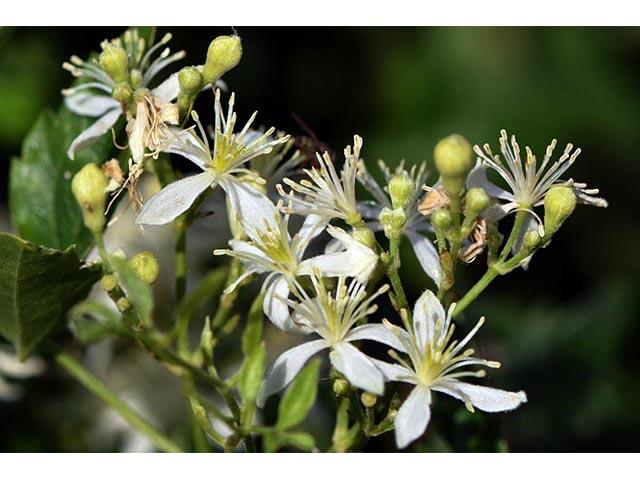
|
Correa ‘Dusky Bells’
Pronunciation
KOR-ree-uh
Common Name
Australian Fuchsia
Plant Type
Shrub
Mature Size
6 ft. to 8 ft. wide and 2 ft. to 3 ft. tall
Water Requirements
Low: water every three weeks until the root ball is wet
Sun/Shade Requirements
Full to half sun, shade
Wildlife
Flower Color
Reddish pink to red, cream, orange, and greenish yellow
Where to See
Maintenance- Design- Planting Tips
Correa has many attributes that make it ideal for Bay Area gardeners. It thrives in sun, partial sun, or shade; is deer resistant and bird friendly; has pretty, long-lasting flowers that provide winter color; does well with moderate to occasional water; does not get too big; tolerates our alkaline soil; and is evergreen.
Also, the shrub requires no deadheading or pruning, so it is practically maintenance-free. Look for some of the newer cultivars of Correa that have been bred to produce more visible flowers above the foliage. |
Correa alba
Pronunciation
KOR-ree-uh AL-ba
Common Name
Australian Fuchsia, White
Plant Type
Shrub
Mature Size
8 ft. high and wide
Water Requirements
Low: water every three weeks until the root ball is wet
Sun/Shade Requirements
Full to half sun, shade
Wildlife
Flower Color
Where to See
Maintenance- Design- Planting Tips
Correa alba looks very different from the more commonly grown Correa ‘Dusky Bells’. The flowers are more open and less downward facing than other Correas. The foliage is fuzzy on the back side and the stems are bronzy brown. This shrub can grow to 8 feet by 8 feet without regular pruning.
Like Correa ‘Dusky Bells’, Correa alba thrives in sun, partial sun, or shade; is deer resistant and bird friendly; and has long-lasting flowers. The plant does well with moderate to occasional water, tolerates alkaline soil, and is evergreen. The plant is sensitive to overwatering and overfertilizing. PADG notes: Some find Correas to be short-lived but at the Palo Alto Demonstration Garden, this plant is still going strong after several years in the garden. The beds in garden are mulched with wood chips, but not fertilized and watered deeply with drip irrigation once every three weeks. |
Cotyledon orbiculata var. oblonga ‘Macrantha’
Pronunciation
kot-EE-lee-don Or-bee-kul-AY-tuh
Common Name
Pig's Ear
Plant Type
Succulent
Mature Size
3 ft. tall and 2 ft. wide
Water Requirements
Low: water every three weeks until the root ball is wet
Sun/Shade Requirements
Full to half sun, shade
Wildlife
Flower Color
No flowers
Where to See
Maintenance- Design- Planting Tips
Cotyledon orbiculata has large, bright green, red-edged leaves. Many summer-dry plants have small, fine leaves so these brightly colored, fleshy leaves add a much needed punch to the garden. This is especially important during the quiet months in the fall and winter when not much is blooming.
Like many succulents, Cotyledon orbiculata is easily propagated from cuttings and does well in containers. It is cold hardy to 20–25°F. |
Dierama pendulum
Pronunciation
dy-er-AH-muh
Common Name
Fairy Wand, Angel’s Fishing Rod
Plant Type
Bulb
Mature Size
Leaves to 2 ft. long, stems 4-7 ft. tall
Water Requirements
Low: water every three weeks until the root ball is wet
Sun/Shade Requirements
Full sun
Wildlife
Flower Color
Purplish pink to pink to white
Where to See
Maintenance- Design- Planting Tips
Fairy Wand, also known as Angel’s Fishing Rod, has stunning flowers on long arching stems. It is certainly a “what is that?!” plant when it blooms in late spring and early summer. Be sure to put it in a spot that will showcase its tall blooms.
If the plant gets too big, the corms can be divided and replanted. Fairy Wand self sows, though heavy mulching may discourage seedlings. If reseeding is a problem, deadhead the flowers before they set seed. Fairy Wand is usually evergreen in Santa Clara County’s climate, but leaves can be cut back in mid-summer if they become unattractive. Otherwise, this is a trouble-free plant with a big impact when it blooms. PADG notes: Fairy Wand is said to need regular water, but a once every three weeks watering regime has worked well. |
Echeveria sp.
Pronunciation
ech-eh-ver-EE-a
Common Name
Plant Type
Succulent
Mature Size
Less that 1 ft. tall and wide
Water Requirements
Low: water every three weeks until the root ball is wet
Sun/Shade Requirements
Half sun to shade
Wildlife
Flower Color
Pink, red with yellow tips
Where to See
Maintenance- Design- Planting Tips
Echeveria is a good filler or edging plant for the summer-dry flower border and also does well in pots. The sculptural quality of the fleshy leaves provides a nice contrast to the more delicate leaves of many perennials.
Echeverias are sometimes called ‘Hen and Chicks’, but so are Sempervivums, another succulent. It's one of the problems with using common names. In this case, it is better to use the botanical name, Echeveria. PADG Notes: Echeveria ‘Imbricata’, a UC Davis Arboretum All-Star, is featured in the Demonstration Garden. Some Echeverias do well in full sun, but Imbricata seems to do better in half shade and with a drip very close to the roots. |
Echinacea purpurea
Pronunciation
ek-ih-AY-shee-a pur-PUR-ee-ah
Common Name
Purple cone flower
Plant Type
Perennial
Mature Size
3'-4' high x 2' wide
Water Requirements
Low: water every three weeks until the root ball is wet
Sun/Shade Requirements
Full sun
Wildlife
Flower Color
Purple
Where to See
Maintenance- Design- Planting Tips
Echinacea purpurea is a green-leaved perennial that produces large purple, daisy-like blooms in the summer. It can grow to four feet in height and works well in the background of garden borders. It needs minimal drip irrigation, dies down after bloom, and resprouts in the spring with little extra maintenance required. |
Echinops ritro ‘Taplow Blue’
Pronunciation
EK-in-ops RIH-tro
Common Name
Globe Thistle
Plant Type
Perennial
Mature Size
2 - 4 ft. tall and 2 ft. wide
Water Requirements
Low: water every three weeks until the root ball is wet
Sun/Shade Requirements
Full sun
Wildlife
Flower Color
Bright blue
Where to See
Maintenance- Design- Planting Tips
Echinops has beautiful blue flowers that bloom spring through fall. The coarse leaves may not appeal to everyone, but they add a different texture to the garden. Echinops make a great cut flower. The spiky texture adds interest to flower arrangements.
Even with minimal water and no fertilizer, these plants need staking. Supports put in place in the early spring are quickly covered with foliage and hidden from view. To encourage new blooms and keep the plant looking fresh, remove the entire flowering stalk. |
Eriogonum fasciculatum
Pronunciation
er-ih-OG-uh-num fas-sik-yoo-LAH-tum
Common Name
California buckwheat
Plant Type
Shrub
Mature Size
2' high x 4'-5' wide
Water Requirements
Low: water every three weeks until the root ball is wet
Sun/Shade Requirements
Full sun
Wildlife
Flower Color
Maintenance- Design- Planting Tips
Eriogonum fasciculatum is a drought-tolerant California native shrub. Reaching only two feet in height with a four-to-five-foot spread, it is a good mid-border choice. The shrub has many branches that are densely covered with small, dark green, needle-like leaves and is covered with pinkish-white clusters of tiny flowers in spring which turn an attractive rust color in summer and fall. When not flowering, it is an attractive contrast to other plants in the mixed border. Trim flowers off when they become unsightly and lightly shape the plant. Do not prune heavily.
|
Erythranthe guttata
Pronunciation
er-EE-thranthe goo-TA-ta
Common Name
Monkey Flower
Plant Type
Perennial
Mature Size
2 1/2 ft. tall and wide
Water Requirements
Low: water every three weeks until the root ball is wet
Sun/Shade Requirements
Full to half sun, shade
Wildlife
Flower Color
White, cream, yellow, orange, copper, salmon, red, maroon
Where to See
Maintenance- Design- Planting Tips
Mimulus is a cheerful California native that adds bright color to the garden. This shrubby perennial has been hybridized heavily to produce a rainbow of colors. In the wild, different species of Mimulus can be found from southern Oregon to southern California.
Happy in sun or part shade, these plants prefer good drainage. With supplemental water, you can expect some repeat bloom all summer. Mimulus is a favorite in native plant gardens because of its color range. When new foliage appears at its base in late winter, the plant is ready to be pruned back to the new green growth. This hard pruning will rejuvenate the plant. If there is no growth at the base, then gently pinch the tips to encourage new growth. The scientific name of this plant was recently changed from Mimulus guttatus to Erythranthe guttata. PADG notes: Some Master Gardeners have found this plant to be short-lived; other Master Gardeners have Mimulus plants in their personal gardens that are over five years old and doing just fine. These plants are easy to propagate from cuttings and seeds. |
Eschscholzia californica
Pronunciation
esh-SHOLZ-ee-ah cal-ih-FOR-nih-kah
Common Name
California Poppy
Plant Type
Perennial
Mature Size
6 in. wide and 6 in. to 12 in. tall
Water Requirements
Low: water every three weeks until the root ball is wet
Sun/Shade Requirements
Full sun
Wildlife
Flower Color
Bright orange, golden, pale yellow, red, cream, rose
Where to See
Maintenance- Design- Planting Tips
California poppies look great in wild areas and are lovely massed. They make excellent temporary fillers in new beds and landscapes. California poppies can get by with almost no summer water, but they tend to look shabby and weedy under these conditions. To encourage continuous bloom, provide moderate amounts of water and trim the plants back to almost ground level when the foliage turns grey, and the plants lose their flowers. Although California poppies are perennials in the Santa Clara Valley, they can be treated as annuals. California poppies can be problematic because they are aggressive reseeders. They should be heavily thinned even in desired areas and removed entirely when undesired. They can reach one and a half feet wide in size and can smother other plants. Most retail nurseries and many hardware stores sell seeds for California poppies. Some mail order companies are good sources for some of the less common varieties of these California natives. Plant seeds in the fall for a spring show. Be sure to cover seeds with mulch to hide them from the birds and water regularly until they sprout if the winter rains have not arrived. |
Euphorbia myrsinites
Pronunciation
yew-FOR-bee-ah mur-zin-EYE-teez
Common Name
Creeping Spurge
Plant Type
Groundcover
Mature Size
6 - 12 in. tall and 12 in. wide
Water Requirements
Low: water every three weeks until the root ball is wet
Sun/Shade Requirements
Full to half sun
Wildlife
Flower Color
Yellow
Where to See
Maintenance- Design- Planting Tips
With its eye catching texture and showy flowers in the spring, Euphorbia myrsinites makes an attractive ground cover for dry areas. These plants will reseed vigorously if not deadheaded, so be sure to cut off the flowering stalks before seeds develop. Leave new growth intact since that will be next spring's flowers.
Take care when cutting Euphorbias because the milky sap can be very irritating to the skin. |
Euphorbia rigida
Pronunciation
yew-FOR-bee-ah RIH-jih-dah
Common Name
Euphorbia
Plant Type
Perennial
Mature Size
3 ft. to 4 ft. high and wide
Water Requirements
Low: water every three weeks until the root ball is wet
Sun/Shade Requirements
Full to half sun
Wildlife
Flower Color
Where to See
Maintenance- Design- Planting Tips
Hundreds of varieties of Euphorbias are available ranging from groundcovers to shrubs. These Mediterranean perennials are hardy plants. Chartreuse or lime green flowers appear in late winter and hold well through spring. Euphorbias are very showy in the winter garden and continue looking good during the hot summer.
Euphorbias can be aggressive reseeders so cut off the flower stalks at the base sometime in May before they set seed. Be careful of the sap as it may irritate the skin. |
Festuca idahoensis
Pronunciation
fess-TOO-kah eye-duh-ho-EN-sis
Common Name
Idaho Fescue
Plant Type
Grass
Mature Size
1 ft. to 2 ft. tall and wide
Water Requirements
Low: water every three weeks until the root ball is wet
Sun/Shade Requirements
Shade
Wildlife
Flower Color
No flowers
Where to See
Maintenance- Design- Planting Tips
Idaho fescue is common native grass in California and many other western states. Without summer water, they turn brown and scraggly. Even with occasional summer water, Festucas do better shadier areas than in full sun. Miscanthus, another type of grass, does better in full sun, but is larger than Festucas.
PADG notes: The Palo Alto Demonstration Garden is still searching for a grass that is low growing and does well in full sun with limited water. |
Ficus carica ‘Panachée’
Pronunciation
FY-kus KAR-ih-kah
Common Name
Panachée Striped Tiger Fig
Plant Type
Tree
Mature Size
15 -30 ft.
Water Requirements
Low: water every three weeks until the root ball is wet
Sun/Shade Requirements
Full sun
Wildlife
Flower Color
None
Where to See
Maintenance- Design- Planting Tips
Tiger figs have beautiful striped, green fruit and large attractive leaves. The fruit requires a long warm season to ripen, which may not be possible in all parts of Santa Clara Valley. See the fig page for more information about growing figs.
PADG notes: PADG's two Tiger fig trees were too large for the modest-sized beds where they were planted, so had to be heavily pruned every year to keep them small enough. The Tiger figs have been removed and replaced with a dwarf fig cultivar called “Black Jack”. |
Gazania
Pronunciation
gay-ZAY-nee-uh
Common Name
Gazania
Plant Type
Groundcover
Mature Size
6 in. tall and 12 in. wide
Water Requirements
Low: water every three weeks until the root ball is wet
Sun/Shade Requirements
Full sun
Wildlife
Flower Color
Yellow, orange, white, and pink
Where to See
Maintenance- Design- Planting Tips
Gazanias are colorful, easy to grow, low water plants. Gazanias do better with only occasional water because they can become leggy if given regular water. Cultivars with silver foliage blend particularly well with other Mediterranean plants. Tired blooms can be deadheaded although it is not necessary. If a clump of plants becomes too crowded or too large, divide the plant during the cool season.
PADG notes: Gazanias have been planted along the edges of the Demonstration Garden to help tie together different beds. |
Geranium x cantabrigiense ‘Biokovo’
Pronunciation
ji-RAY-nee-uhm kan-tuh-brij-ee-EN-see
Common Name
Cranesbill ‘Biokovo’
Plant Type
Groundcover
Mature Size
6 - 8 in. tall and spreading
Water Requirements
Low: water every three weeks until the root ball is wet
Sun/Shade Requirements
Full to half sun, shade
Wildlife
Flower Color
Pale pink
Where to See
Maintenance- Design- Planting Tips
This pretty ground cover is good for dry shady areas. The pale pink flowers have a long season and complement a variety of plants, from roses to California native shrubs to coast live oaks. It's easy to propagate and transplant to new areas. Just cut off a small piece, plant it directly in the soil and keep it wet until the plant roots. Shear in the fall to get fresh growth in the spring.
Be aware that geranium ‘Biokovo’ can become aggressive and spread quickly if planted in soil that is fertilized and watered regularly. |
Grevillea lanigera ‘Coastal Gem’
Pronunciation
grev-ILL-ee-uh lan-EE-ger-ruh
Common Name
Wooley Grevillea
Plant Type
Shrub
Mature Size
1'-1.5' high x 4'-5' wide
Water Requirements
Low: water every three weeks until the root ball is wet
Sun/Shade Requirements
Full to half sun
Wildlife
Flower Color
Where to See
Maintenance- Design- Planting Tips
Grevillea lanigera ‘Coastal Gem’ is covered with showy pink flowers from fall into spring, providing color when most plants do not bloom. Plan the garden so the remaining spring blossoms accent the early spring blooms on other plants. When not in bloom, this is a compact and attractive shrub with gray-green leaves. It is very drought tolerant once established.
|
Grevillea rosmarinifolia
Pronunciation
grah-VIL-ee-ah rose-ma-ree-nee-FOH-lee-uh
Common Name
Grevillea
Plant Type
Shrub
Mature Size
3 ft. high and 6 ft. wide
Water Requirements
Low: water every three weeks until the root ball is wet
Sun/Shade Requirements
Full to half sun
Wildlife
Flower Color
Red and cream
Where to See
Maintenance- Design- Planting Tips
Grevillea is a no fail plant. It's tough, deer resistant, loved by hummingbirds, and a fall to spring bloomer.
The Grevillea pictured is a dwarf form of Grevillea rosmarinifolia. It has evergreen rosemary-like leaves and stays about 3 feet high by 6 feet wide. It flowers in the winter when not much is blooming and provides a tidy, low growing shrub in the summer when other plants take center stage. Grevillea does well with a deep watering once every three weeks. It also grows well in gardens that get regular water. Be careful of using fertilizer with phosphorus around Grevillea. No maintenance, deadheading, or trimming back is required for this plant. Note that there are over 250 species and hybrids of Grevillea. Some have fine leaves; others have courser leaves. Some make great ground covers; others grow to be the size of the small trees. Some tolerate cold weather better than others. Research cultivars carefully before selecting plants. |
Helianthemum nummularium ‘Henfield Brilliant’
Pronunciation
hee-lee-AN-them-um num-ew-LAH-ree-um
Common Name
Sunrose
Plant Type
Groundcover
Mature Size
6 in. to 12 in. high and 18 in. to 3 ft. wide
Water Requirements
Low: water every three weeks until the root ball is wet
Sun/Shade Requirements
Full to half sun
Wildlife
Flower Color
Orange-red
Where to See
Maintenance- Design- Planting Tips
A low-growing, trailing ground cover from Turkey, Helianthemum is covered with small flowers in the spring. There are many cultivars with different flower colors — red, apricot, yellow, pink, and white. ‘Henfield Brilliant’ is a striking form with its silvery leaves and orange flowers.
Helianthemum likes full sun and well-draining soil with low to moderate water. Shear off the dead flowers to encourage repeat blooms. |
Hesperaloe parviflora
Pronunciation
hes-per-AL-oh par-VEE-flor-uh
Common Name
Coral yucca
Plant Type
Perennial
Mature Size
3'-4' high x 4'-5' wide
Water Requirements
Low: water every three weeks until the root ball is wet
Sun/Shade Requirements
Full to half sun
Wildlife
Flower Color
Red
Where to See
Maintenance- Design- Planting Tips
Hesperaloe parviflora is a standout plant for any garden and is on the UC Davis Arboretum All-Star list. The three- to four-foot-high rosettes of stiff yucca-like, blue-green leaves provide structural interest all year long. From spring into summer, five-foot-long flower stalks sport many striking red flowers followed by interesting seed pods. This plant is drought tolerant, low maintenance, and very reliable, with few pest and disease problems.
|
Heuchera maxima
Pronunciation
HEW-ker-ah MAX-im-a
Common Name
Island Alumroot
Plant Type
Perennial
Mature Size
1-2 ft tall x 3-4 ft wide
Water Requirements
Low: water every three weeks until the root ball is wet
Sun/Shade Requirements
Full to half sun
Wildlife
Flower Color
Pinkish-white
Where to See
Maintenance- Design- Planting Tips
Heuchera maxima is a California native plant from the Channel Islands. This heuchera is one of the largest of this genus. It forms a low clump and looks great planted in mass, especially in early spring when delicate flowers appear on thin stalks above the large green leaves. The flowers are useful as a cut flower. It is on the UC Davis Arboretum All-Star list
PADG notes: In the Water Wise Garden, several Heuchera maxima are growing in a shady spot where the soil is quite rich. These plants have grown very large and are stunning in the spring when they bloom. |
Hypericum reptans
Pronunciation
hy-PARE-ih-kum REP-tanz
Common Name
St. Johnswort
Plant Type
Groundcover
Mature Size
2 in. tall and 1 1/2 in. wide
Water Requirements
Low: water every three weeks until the root ball is wet
Sun/Shade Requirements
Full to half sun
Wildlife
Flower Color
Bright yellow
Where to See
Maintenance- Design- Planting Tips
Hypericum reptans, or ground cover St. Johns’s Wort, is ideal for dry sunny and partially shady areas. This ground cover looks and behaves differently from other species of St. John’s Wort. It has very small leaves and flowers, grows close to the ground and spreads slowly, with yellow flowers appearing in the summer.
Spent flowers can be sheared off when the plant is done blooming. It is easy to start new plants by planting cuttings directly into the soil when the weather has cooled. |
Iris ‘Canyon Snow’
Pronunciation
EYE-riss
Common Name
Pacific Coast Iris ‘Canyon Snow’
Plant Type
Bulb
Mature Size
Flower stems reach 8 in. to 24 in. high
Water Requirements
Low: water every three weeks until the root ball is wet
Sun/Shade Requirements
Full to half sun
Wildlife
Flower Color
White
Where to See
Maintenance- Design- Planting Tips
There are many hybrids of Pacific Coast iris, some of which are very showy. Flower colors available include white, blue, pink, copper, brown, maroon, and violet. The flowers appear in the spring. The cultivar ‘Canyon Snow’ is said to tolerate full sun better than many other California native irises, as well as being more vigorous and floriferous. UC Davis has included this cultivar on the Arboretum All-Stars list.
Master Gardeners have found that Pacific Coast irises seem to prefer part shade and low to moderate water. Native irises are useful under oaks, in woodland gardens, and in meadows. |
Kniphofia
Pronunciation
ny-FOE-fee-ah
Common Name
Red Hot Poker
Plant Type
Perennial
Mature Size
Varies by cultivar
Water Requirements
Low: water every three weeks until the root ball is wet
Sun/Shade Requirements
Full to half sun
Wildlife
Flower Color
Red, orange, yellow, near white
Where to See
Maintenance- Design- Planting Tips
The glowing torch-like flowers spikes of Kniphofia are reliable midsummer bloomers and provide great vertical accents. Many sizes and colors of Kniphofias have been developed, including reds, oranges, yellows, and near whites. The flower colors can be dramatic and intense, so take care in selecting flower colors that blend well with your plants.
Deadhead the plants when the old flower spikes become unattractive. When the leaves start looking shabby in the winter, cut the foliage back about three inches above the ground. Kniphofia will come back beautifully in the spring. The plant divides easily but it doesn't seem to require dividing to stay vigorous. PADG notes: The Palo Alto Demonstration Garden has several Kniphofias including ‘Christmas Cheer', which is a UC Davis Arboretum All-Star. It has brilliant orange buds that open to a deep-gold tubular flower. ‘Christmas Cheer’ blooms in the fall and winter unlike many other Kniphofias. |
Lavandula stoechas ‘Otto Quast’
Pronunciation
lah-VAN-dew-lah STOY-kas
Common Name
Spanish Lavender
Plant Type
Shrub
Mature Size
1 ft. to 2 ft. tall and 2 ft. to 3 ft. wide
Water Requirements
Low: water every three weeks until the root ball is wet
Sun/Shade Requirements
Full sun
Wildlife
Flower Color
Purple
Where to See
Maintenance- Design- Planting Tips
Lavenders are a favorite plant for low-water gardens with their aromatic foliage and showy spikes of scented flowers. Full sun and good drainage are essential for lavenders. Shear the plant after blooming to maintain a neat appearance and discourage the plant from becoming too large and woody. Lavender is a short-lived shrub that may need to be replaced when it becomes leggy or woody after about six years.
Lavandula stoechas is an early bloomer and will repeat bloom if deadheaded and given supplemental water. PADG notes: Several different types of lavenders are planted in the Demonstration Garden, including ‘Otto Quast’, a successful cultivar which is also a UC Davis Arboretum All-Star plant. |
Leonotis leonurus
Pronunciation
lee-oh-NO-tus lee-oh-NURE-us
Common Name
Lion’s Tail
Plant Type
Shrub
Mature Size
4 ft. to 6 ft. wide and tall
Water Requirements
Low: water every three weeks until the root ball is wet
Sun/Shade Requirements
Full sun
Wildlife
Flower Color
Orange-red
Where to See
Maintenance- Design- Planting Tips
This upright shrub from South Africa has bright eye-catching orange flowers. A single lion’s tail works well as a late summer/early fall garden focal point. The flowers can also be stunning in a flower arrangement.
Prune these shrubs in the early spring after the danger of frost is past to control size. Some gardeners prune them down to six inches from the ground; others just cut off half of the total height. How much to prune is a matter of deciding the desirable size of the plants in the garden. With no pruning at all, these plants can get very large, very quickly. Lion’s tail can be frost tender, but they rebound quickly. If this plant does get frost damaged, wait until after the danger of frost is past, then cut off the damaged parts. |
Leucadendron ‘Jester’
Pronunciation
lew-kuh-DEN-dron
Common Name
Jester Conebush
Plant Type
Shrub
Mature Size
4 ft. to 6 ft. tall and wide
Water Requirements
Low: water every three weeks until the root ball is wet
Sun/Shade Requirements
Full sun
Wildlife
Flower Color
Rose, red or yellow
Where to See
Maintenance- Design- Planting Tips
Leucadendrons are evergreen shrubs from South Africa and are related to Proteas. Some Leucadendrons have interesting cone-like heads with colorful bracts that may be used in flower arrangements; others are grown primarily for their foliage.
Plant Leucadendrons on one-foot mounds to encourage good drainage. Their color and size add a bit of drama to the beds, especially during periods where other plants are dormant. PADG notes: There are several different cultivars of Leucadendrons in the garden, including this one. ‘Jester’ is also known as ‘Safari Sunshine'. |
Leucadendron ‘Rising Sun'
Pronunciation
lew-kuh-DEN-dron
Common Name
Rising Sun Conebush
Plant Type
Shrub
Mature Size
6 ft. to 8 ft. tall and wide
Water Requirements
Low: water every three weeks until the root ball is wet
Sun/Shade Requirements
Full sun
Wildlife
Flower Color
Red
Where to See
Maintenance- Design- Planting Tips
Leucadendron ‘Rising Sun’ is a South African native, with beautiful reddish stems and terminal bracts (colorful flower-like leaves toward the end of a stem). Some Leucadendrons can be frost tender.
PADG notes: This Leucadendron stayed small, so pruning hasn’t been necessary. It may be because it was planted on top of a gravel mound and received limited water. However, we removed Rising Sun from the Palo Alto Demonstration Garden because it had a twisting way of growing that we didn't find attractive. |
Linaria purpurea
Pronunciation
lin-AR-ee-uh pur-PUR-ee-uh
Common Name
Purple Toadflax
Plant Type
Perennial
Mature Size
2 - 3 ft. high and 1 ft. wide
Water Requirements
Low: water every three weeks until the root ball is wet
Sun/Shade Requirements
Full to half sun
Wildlife
Flower Color
Where to See
Maintenance- Design- Planting Tips
Linaria is an old friend that asks for little and gives much. This plant makes a great filler, especially in a young garden. The flowers are small, but the plant is large with many blooming branches. Sunset recommends planting these plants in mass for maximum impact.
The big drawback to Linaria is that it reseeds. The seedlings are easy to spot and pull out. If you deadhead the flowers and mulch your soil regularly you will cut down on the amount of reseeding. |
Lobelia laxiflora
Pronunciation
lo-BEE-lee-ah laks-ih-FLO-ruh
Common Name
Mexican Lobelia
Plant Type
Perennial
Mature Size
3 ft. to 6 ft. wide and 3 ft. tall
Water Requirements
Low: water every three weeks until the root ball is wet
Sun/Shade Requirements
Full to half sun
Wildlife
Flower Color
Red with yellow tips
Where to See
Maintenance- Design- Planting Tips
Many Lobelias need lots of water, but not this lovely red Mexican lobelia. Though very frost tender, Mexican lobelia comes back from the root stock in the spring. This lobelia can spread aggressively, so it is not recommended for someone looking for a low maintenance plant.
PADG Notes: After frost damage, scraggly branches are pruned back to about three feet for a neater appearance. When danger of frost is gone, the plant is pruned to the ground. Mexican lobelia has spread aggressively in the garden and needs regular root pruning to keep under control. Warning: Lobelia may cause serious illness or death if eaten. If ingested, immediately call the Poison Control Center or your doctor. In addition, the juice or sap of the plant can cause a skin rash or irritation. Wash the affected area of skin with soap and water as soon as possible after contact.
|
Maianthemum stellatum
Pronunciation
mie-ANTH-uh-moom stel-AH-toom
Common Name
False Solomon Seal
Plant Type
Perennial
Mature Size
1 - 2 ft. (0.3 - 0.6 m) wide x 2.5 ft.(0.8 m) tall
Water Requirements
Low: water every three weeks until the root ball is wet
Sun/Shade Requirements
Shade
Wildlife
Flower Color
White, Red
Where to See
Maintenance- Design- Planting Tips
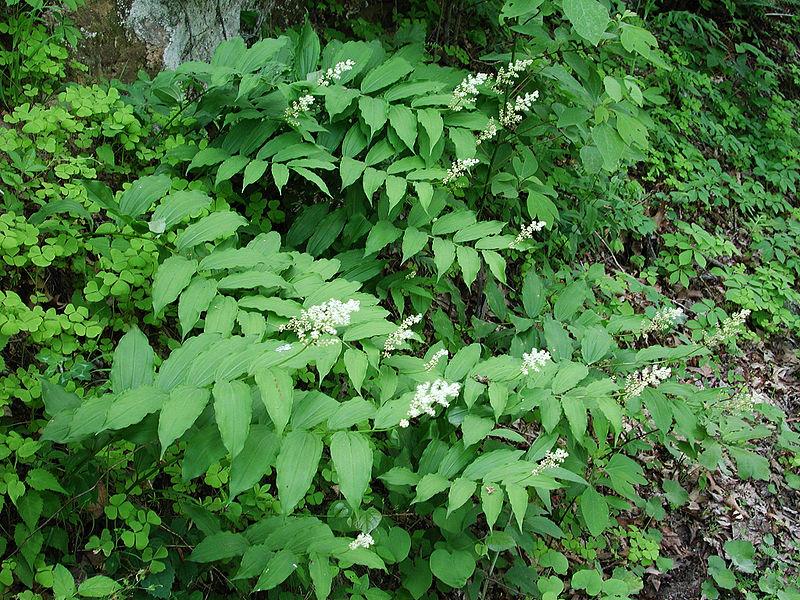
|
Miscanthus sinensis 'Yaku Jima'
Pronunciation
mis-KAN-thus sih-NEN-sis
Common Name
Silver Grass 'Yaku Jima'
Plant Type
Grass
Mature Size
2 ft. to 3 ft. wide and tall with plumes rising 4 ft. to 5 ft.
Water Requirements
Low: water every three weeks until the root ball is wet
Sun/Shade Requirements
Full to half sun
Wildlife
Flower Color
Striking golden plumes in fall
Where to See
Maintenance- Design- Planting Tips
There are many cultivars of Miscanthus on the market that vary in size and foliage color including silver and reddish brown. The cultivar 'Yaku Jima' is a U.C Davis “All Star” plant.
From a design perspective, the delicate foliage and showy plumes of Miscanthus add movement and texture to the garden. The plumes look especially lovely in the fall afternoon light. To keep a fresh look, cut Miscanthus to the ground in winter and divide every few years. That is the only maintenance needed for these trouble-free plants. Miscanthus sometimes takes a year or so to get established. PADG Notes: Miscanthus 'Yaku Jima' is a favorite of Roberta Barnes, one of the founders of the Palo Alto Water Wise Demonstration Garden. She has found Miscanthus to be one of the best-looking grasses for full sun and low water. There have not been any problems with this grass reseeding in the Demonstration Garden. |
Muhlenbergia dubia
Pronunciation
muh-len-BER-jee-ah DOO-bee-uh
Common Name
Pine Muhly
Plant Type
Grass
Mature Size
2 ft. to 3 ft. wide and tall with plumes rising 4 ft. to 5 ft.
Water Requirements
Low: water every three weeks until the root ball is wet
Sun/Shade Requirements
Full sun
Wildlife
Flower Color
No flowers
Where to See
Maintenance- Design- Planting Tips
Muhlenbergia dubia from the southwest U.S. is a favorite grass for the summer dry garden. It looks very similar to the more common Muhlenbergia rigens (deer grass), but it is a third of its size. That makes this plant a better choice for pots and small spaces.
Like most grasses Muhlenbergia dubia really shines in the fall when its graceful leaves add movement and texture to the garden. PADG notes: Every spring, older growth is raked out to encourage new green leaves. Every three years, the plant is sheared down the ground. No other maintenance is done for this plant. |
Muhlenbergia emersleyi
Pronunciation
muh-len-BER-jee-ah e-MERS-lee-eye
Common Name
Bull Grass
Plant Type
Grass
Mature Size
1 1/2 ft tall and 3 - 4 ft wide
Water Requirements
Low: water every three weeks until the root ball is wet
Sun/Shade Requirements
Full to half sun
Wildlife
Flower Color
No flowers
Where to See
Maintenance- Design- Planting Tips
Muhlenbergia emersleyi is a wonderful grass to include in perennial flower beds because it doesn't get too big. In the late summer and fall this grass has attractive reddish flower spikes on green foliage. The winter form is lovely as well. Some describe the winter color as cream, tan or brown. This grass would look attractive planted in a larger group or even in a meadow.
This plant can be hard to find, but is well worth requesting from a nursery as a special order. PADG Notes: This grass is extremely low maintenance and unlike many other grasses doesn't need to be divided every couple years. To keep this grass attractive, the old foliage is raked out to make room for the green spring growth. |
Muhlenbergia rigens
Pronunciation
muh-len-BER-jee-ah RIG-ens
Common Name
Deer Grass
Plant Type
Grass
Mature Size
3 ft. wide and tall
Water Requirements
Low: water every three weeks until the root ball is wet
Sun/Shade Requirements
Full to half sun
Wildlife
Flower Color
No flowers
Where to See
Maintenance- Design- Planting Tips
Grasses are the backbone of late summer and fall dry perennial gardens, adding movement and texture. The graceful leaves of grasses look particularly beautiful when highlighted by the late afternoon sun.
Muhlenbergia rigens is a reliably pretty California native grass. The flower stalks are persistent and look attractive year-round. The UC Davis Arboretum, which has selected Muhlenbergia as one of their "All Stars", suggests using it as a low informal screen. Muhlenbergia requires very little maintenance. UC Davis recommends shearing Muhlenbergia a couple inches above the ground in the early spring every three years to encourage new green growth. California Native Plants for the Garden suggests periodically raking out dead foliage with a fan rake. Otherwise, this is a maintenance-free plant. PADG notes: This plant is used as an accent plant in both the native and non-native garden beds with good results. PADG Garden also grows Muhlenbergia dubia, a smaller cultivar. This is an attractive low-water plant, although the UC Davis Arboretum suggests giving M. dubia slightly more water than M. rigens. |
Nepeta x faassenii
Pronunciation
NEP-eh-tah ex. fah-SEEN-ee-eye
Common Name
Catmint
Plant Type
Groundcover
Mature Size
1 ft. tall and 1 1/2 - 2 ft. wide
Water Requirements
Low: water every three weeks until the root ball is wet
Sun/Shade Requirements
Full to half sun
Wildlife
Flower Color
Lavender-blue
Where to See
Maintenance- Design- Planting Tips
Catmint is a reliable and easy edging plant for low water perennial borders. It has lovely soft gray leaves and lavender-blue flowers in the spring.
After the first set of blooms finishes, catmint should be cut back several inches to keep it from getting leggy and encourage another set of blooms. This is a fun job because the leaves have a wonderful smell. Be aware that some cats also love the smell of the plant and will roll their bodies in the plant and flatten it. PADG Notes: Catmint was one of the earliest plants in the Demonstration Garden providing much needed color the first summer. It is used extensively to visually tie the beds together.
|
Origanum
Pronunciation
oh-Rig-an-um
Common Name
Oregano
Plant Type
Perennial
Mature Size
Varies depending on cultivar
Water Requirements
Low: water every three weeks until the root ball is wet
Sun/Shade Requirements
Full sun
Wildlife
Flower Color
No flowers
Where to See
Maintenance- Design- Planting Tips
Herbs like oregano are very attractive, can be mixed with ornamental plantings and thrive under tough conditions. Some oreganos are grown for their aromatic qualities, others for their interesting foliage and others for their attractive flowers. 'Hopley's', a variety with purplish pink flowers that is attractive in pots. 'Aureum', the variety shown in this picture, looks better with morning sun. The hot afternoon sun can bleach its leaves.
Herbs are also great for attracting beneficial insects to gardens. And the less they are watered, the more intense the flavor. Many oreganos benefit from being sheared to the ground in the fall. Harvest oregano any time for cooking, but the most intense flavor is just before the plants bloom. |
Pelargonium ionidiflorum
Pronunciation
pe-lar-GO-nee-um eye-oh-nid-ih-FLOR-um
Common Name
Celery Scented Pelargonium
Plant Type
Groundcover
Mature Size
12 - 18 in. high and 15 -24 in. wide
Water Requirements
Low: water every three weeks until the root ball is wet
Sun/Shade Requirements
Half sun to shade
Wildlife
Flower Color
Magenta pink
Where to See
Maintenance- Design- Planting Tips
Pelargonium ionidiflorum blooms throughout the year with bright pink flowers. Attractive when grown in front of border plants, it stays low and compact and seems to do well in partial shade. Unlike other Pelargoniums, this plant does not get leggy. Maintenance is minimal, and occasional deadheading is all that is needed.
|
Pelargonium sidoides
Pronunciation
pe-lar-GO-nee-um sih-DOY-deez
Common Name
African Geranium
Plant Type
Perennial
Mature Size
1 ft. wide and tall forming a dense mound
Water Requirements
Low: water every three weeks until the root ball is wet
Sun/Shade Requirements
Full to half sun
Wildlife
Flower Color
Dark purple
Where to See
Maintenance- Design- Planting Tips
Pelargonium sidoides has elegant dark purple flowers and dense mounds of silver-gray, heart-shaped leaves. Masses of the dark purple flowers bloom all the way through mid-December with or without deadheading. Even without flowers, African geranium still looks great in the garden because of its attractive foliage.
This is a geranium that thrives in low water situations and in full sun. It can also do well in part shade with generous water. This cultivar seems to be more cold hardy than other Pelargonium. The only regular maintenance it needs is occasional deadheading. |
Philotheca myoporoides ‘Profusion’
Pronunciation
fil-oh-THEK-uh my-oh-por-OY-deez
Common Name
Waxflower 'Profusion'
Plant Type
Shrub
Mature Size
4 - 5 ft. tall and wide
Water Requirements
Low: water every three weeks until the root ball is wet
Sun/Shade Requirements
Full to half sun
Wildlife
Flower Color
White
Where to See
|
Phlomis fruticosa
Pronunciation
FLOW-miss fru-tih-KOE-sah
Common Name
Jerusalem Sage
Plant Type
Shrub
Mature Size
4 ft. tall and wide
Water Requirements
Low: water every three weeks until the root ball is wet
Sun/Shade Requirements
Full sun
Wildlife
Flower Color
Where to See
Maintenance- Design- Planting Tips
From the Mediterranean Basin, this sun-loving shrub has unique yellow ball-shaped flowers. The large wooly-gray leaves are a good texture complement to other water-wise plants, many of which have small-leaves to conserve water.
Occasional water will encourage repeat blooms. However, Phlomis fruticosa will tolerate very dry conditions. This plant can be cut back by half in the fall to keep it compact. Some Master Gardeners are a little more daring and like to cut Phlomis back to six inches above the ground. This will keep the plant even more compact. Another option is to do nothing at all if the size and woodiness of the plant are not an issue. |
Phormium tenax 'Amazing Red'
Pronunciation
FORM-ee-um TEN-ax
Common Name
New Zealand Flax 'Amazing Red'
Plant Type
Perennial
Mature Size
3 ft. wide and tall
Water Requirements
Low: water every three weeks until the root ball is wet
Sun/Shade Requirements
Full to half sun
Wildlife
Flower Color
Red (but grown more for foliage)
Where to See
Maintenance- Design- Planting Tips
'Amazing Red' is one of the smaller Phormium cultivars. The sharp texture and brownish-red color of the leaves makes this plant an excellent focal point in the perennial bed.
Some Phormiums revert to the brownish color of the species after several years. 'Amazing Red' has held its color in the demonstration garden for six years and for ten years in some Master Gardeners' personal gardens. To maintain, prune out dead leaves at their base, but don't try to reduce size of Phormiums by cutting back the leaves. Unlike grasses, Phormium leaves won't grow back, leaving stubby unattractive leaves. PADG notes: Though it is supposed to be small, in the demonstration garden this plant has grown to about 3 feet high and wide in six years, larger than expected. The plant has not bloomed. |
Polystichum munitum
Pronunciation
pol-ISS-tih-kum MEW-nih-tum
Common Name
Western Sword Fern
Plant Type
Perennial
Mature Size
3 - 5 ft. tall and 3 - 4 ft wide
Water Requirements
Low: water every three weeks until the root ball is wet
Sun/Shade Requirements
Shade
Wildlife
Flower Color
No flowers
Where to See
Maintenance- Design- Planting Tips
Western sword ferns are found in in forests throughout California and much of the west. These ferns help give shady landscapes a natural woodsy look. These plants are very tolerant of competition from tree roots. To keep them looking attractive, remove older fronds. Keep in mind that sword ferns provide forage for elk, deer, and black bears, should you wish for any of these animals in your garden.
|
Punica granatum
Pronunciation
PU-ni-kuh grah-NAT-um
Common Name
Pomegranate
Plant Type
Shrub
Mature Size
15 ft. to 20 ft. tall and wide, but can prune smaller
Water Requirements
Low: water every three weeks until the root ball is wet
Sun/Shade Requirements
Full sun
Wildlife
Flower Color
Orange-red flowers with ornamental yellow, orange, or red fruit
Where to See
Maintenance- Design- Planting Tips
Pomegranates are a small, well-behaved shrub for the perennial garden. The plant flowers in the early summer and has an attractive golden leaf color in the late fall. The fruit, which forms in the mid-fall, adds color to the fall garden. One drawback is pomegranates lose all their leaves in the winter and don't have a particularly attractive branching structure.
Sunset's Western Garden Book recommends regular water, but says pomegranates tolerate considerable drought. A bonus of a low water regime is the tree grows more slowly and requires less frequent pruning. PADG Notes: Pomegranates in the Demonstration Garden do quite well with deep and infrequent watering. They are pruned in the late winter to maintain them as shrubs. Since pomegranates can grow to be quite large, some gardeners may choose to prune off the bottom branches of the shrub to give the plant a pleasing tree-like form. |
Rhodanthemum hosmariense
Pronunciation
rowd-AN-theh-mum hos-mar-ee-EN-see
Common Name
Moroccan Daisy
Plant Type
Groundcover
Mature Size
2 ft. wide and 8 ins. tall
Water Requirements
Low: water every three weeks until the root ball is wet
Sun/Shade Requirements
Full sun
Wildlife
Flower Color
White daisies
Where to See
Maintenance- Design- Planting Tips
Rhodanthemum hosmariense has silver foliage and white daisy flowers. This plant is a good choice as an edging plant. This plant flowers profusely in the winter when not much is in bloom.
Don't over-water this plant or it will rot. It can survive on very little water. Maintenance consists of occasional deadheading of spent flowers. |
Rhus ovata
Pronunciation
rus oh-VAY-tuh
Common Name
Sugar Bush
Plant Type
Shrub
Mature Size
8 ft. to 12 ft. tall and wide
Water Requirements
Low: water every three weeks until the root ball is wet
Sun/Shade Requirements
Full to half sun
Wildlife
Flower Color
Where to See
Maintenance- Design- Planting Tips
The California native, Rhus ovata, is an adaptable plant in the garden. This evergreen shrub can be pruned up by removing the bottom branches to create a small tree. It can also be formed into a hedge or left to grow naturally as a large, rounded shrub. Rhus ovata takes sun or partial shade and tolerates occasional water in the summer.
This plant is more of a garden workhouse rather than a star, but a garden full of stars would be overwhelming. These are good background shrubs for places that get no irrigation. The flower bracts, which appears in the fall, are red and show up well against the shiny green leaves. The flowers appear several months later and are small and white. |
Ribes sanguineum
Pronunciation
RY-beez san-GWIN-ee-um
Common Name
Pink Flowering Currant
Plant Type
Shrub
Mature Size
5 ft. to 12 ft. tall and wide
Water Requirements
Low: water every three weeks until the root ball is wet
Sun/Shade Requirements
Half sun to shade
Wildlife
Flower Color
Pink, red, yellow, white
Where to See
Maintenance- Design- Planting Tips
Ribes sanguineum is a useful landscape plant because it is one of the few shrubs that shine in dry shade. Pink Flowering Currant is one of the first plants to awaken in the spring with a beautiful display of pendulous pink flowers and green maple-like lobed leaves. Ribes, a deciduous shrub, loses all its leaves in the late fall.
This plant can be used as a focal plant in the garden surrounded by smaller perennials or as an understory plant when combined with large trees with low water usage, like California Oaks. It can get by with very little water but looks fuller when a moderate amount of water is applied in the summer. When using Ribes under a California Oak, avoid summer water. There are many different cultivars of Ribes available with flowers ranging from red to pink to yellow to white. Some types of Ribes work well in full sun. Hummingbirds are attracted to the flowers, especially since they bloom when not much else is flowering. In the fall the shrub has blue-black berries that attract fruit-eating birds including mockingbirds and cedar waxwings. Ribes sanguineum is found along the Pacific coast from California to British Columbia, Canada. |
Rosa 'Happenstance'
Pronunciation
ROE-sah
Common Name
Rose 'Happenstance'
Plant Type
Perennial
Mature Size
3 ft. tall and wide with regular pruning
Water Requirements
Low: water every three weeks until the root ball is wet
Sun/Shade Requirements
Full sun
Wildlife
Flower Color
Light yellow to white
Where to See
Maintenance- Design- Planting Tips
Roses have a reputation for being lovely shrubs that require a lot of maintenance and water. 'Happenstance' rose is a beautiful, disease-free shrub rose that does fine on a low water diet.
The pale-yellow flowers of 'Happenstance' provide a calming contrast to more brightly colored flowers. The arching branches of 'Happenstance' rose form a neat mound. PADG Notes: This rose is a slow grower in the garden and doesn't need a lot of deadheading or pruning because it is not highly fertilized or watered. In February, some of the longer canes of 'Happenstance' are pruned back to about two feet to keep the rose a three-foot mounding shrub over the summer. Despite the low maintenance approach, this plant blooms continually in the spring, summer, and fall. It is highly recommended as a medium-sized rose for water-wise perennial gardens. |
Rosa chinensis 'Mutabilis'
Pronunciation
ROE-sah chin-EN-sis mew-TAB-ill-iss
Common Name
Butterfly Rose
Plant Type
Shrub
Mature Size
8 ft. to 10 ft. tall and wide
Water Requirements
Low: water every three weeks until the root ball is wet
Sun/Shade Requirements
Full to half sun
Wildlife
Flower Color
Where to See
Maintenance- Design- Planting Tips
While most hybrid tea roses like regular water and fertilizer, there are many antique roses that withstand tough conditions. Rosa x ordorata 'Mutabilis' is very successful under a low water/no fertilizer regime. This rose prefers full sun but will grow and bloom in part shade.
Rosa 'Mutabilis' grows into a large shrub with delicate blossoms that open orange, then turn pink and finally maroon as it ages. The bronzy colored new foliage is also attractive. Blooming all summer, it is a focal point in the garden. PADG Notes: This rose is pruned back to about four feet in February, selectively cutting smaller branches back to a main stem. This helps keep the plant a manageable size and encourages lots of blooms over the summer. |
Rosmarinus officinalis 'Tuscan Blue'
Pronunciation
ross-mah-RYE-nus oh-fi-shi-NAH-lis
Common Name
Tuscan Blue Rosemary
Plant Type
Shrub
Mature Size
6 ft. to 7 ft. tall and 1 1/2 ft. to 2 ft. wide
Water Requirements
Low: water every three weeks until the root ball is wet
Sun/Shade Requirements
Full sun
Wildlife
Flower Color
Blue
Where to See
Maintenance- Design- Planting Tips
Rosemary is one of the toughest shrubs in the garden and a great evergreen plant to anchor a summer dry bed. It is from the Mediterranean Basin and is well suited to the Santa Clara Valley climate. There are many different varieties and forms, some tall, others spreading. Flower color can also vary from pale blue to deep blue, and less commonly, pink and white.
Rosemary starts blooming in the winter and provides food for bees when little else is blooming. It sometimes has a small bloom in the late summer and fall as well. PADG Notes: The 'Tuscan Blue' rosemary shrubs in the garden have never grown taller than 4 feet and are more ball shaped than vertical. Part of this may be due to less watering and part of this may be due to our pruning regime. It is pruned by one half to one third after it finishes blooming in late spring to control its height. The side branches which fall on other plants are also pruned. Once the plants become mature, up to one third of the large woody branches are pruned to control plant size and maintain vigor. To minimize pruning, we have taken out several of our 'Tuscan Blue' rosemary shrubs and replaced them with the smaller cultivar 'Mozart', a UC Davis Arboretum "All-Star.” |
Rubus pentalobus
Pronunciation
ROO-bus pen-tuh-LOH-bus
Common Name
Creeping Raspberry
Plant Type
Groundcover
Mature Size
6 ft. wide and 6 in. to 12 in. tall
Water Requirements
Low: water every three weeks until the root ball is wet
Sun/Shade Requirements
Half sun to shade
Wildlife
Flower Color
Small white flowers
Where to See
Maintenance- Design- Planting Tips
|
Salvia chamaedryoides
Pronunciation
SAL-vee-uh kam-ay-dry-OY-deez
Common Name
Germander Sage
Plant Type
Perennial
Mature Size
2 ft. wide and 3 ft. to 4 ft. tall
Water Requirements
Low: water every three weeks until the root ball is wet
Sun/Shade Requirements
Full sun
Wildlife
Flower Color
Bright blue
Where to See
Maintenance- Design- Planting Tips
|
Salvia Hybrid 'Christine Yeo'
Pronunciation
SAL-vee-uh
Common Name
Sage 'Christine Yeo'
Plant Type
Perennial
Mature Size
12-18 in. high and 24 - 36 in. wide
Water Requirements
Low: water every three weeks until the root ball is wet
Sun/Shade Requirements
Full to half sun, shade
Wildlife
Flower Color
Where to See
Maintenance- Design- Planting Tips
Salvias microphyllas is a shrubby perennial that come in a wide variety of colors and will bloom many months with deadheading. It stays a manageable size in the garden and will not overwhelm neighboring plants.
The flower pictured here is Salvia hybrid 'Cristine Yeo'. It is a cross between Salvia microphylla and Salvia chamaedryoides. PADG Notes: Salvia microphyllas prefer full sun, but this plant is doing well with morning sun and afternoon shade in our garden. It seems a little floppy, which might be a shade issue or just its natural form. With a little work, the Salvia microphyllas can be kept in top form in your garden. At PADG, all flowers are sheared off in early summer and again during fall clean up. This keeps the plant more compact and encourages repeat blooming. In the spring, one third of is oldest stems are pruned out to keep the plant from getting woody. A nice bonus for pruning work -- the leaves of these Salvias smell wonderful. |
Salvia microphylla 'UCB Pink'
Pronunciation
SAL-vee-uh My-kro-FIL-uh
Common Name
Sage 'UCB Pink'
Plant Type
Perennial
Mature Size
3 ft. to 4 ft. wide and tall
Water Requirements
Low: water every three weeks until the root ball is wet
Sun/Shade Requirements
Full sun
Wildlife
Flower Color
Maintenance- Design- Planting Tips
This hot pink Salvia blooms in late fall when few other plants are blooming. In general Saliva microphylla plants do well in summer-dry perennial gardens and don't need a great deal of maintenance.
PADG Notes: 'UCB Pink' seems to bloom more consistently than many of the Salvia microphylla types. In the fall, the skinny branches of this plant are sheared off to form a neat ball. Avoid cutting into the thicker woody stems because it could affect regrowth. Regular pruning keeps this plant fuller and encourages more flowering the next season. If you want to learn more about Salvias, we suggest reading Betsy Clebsch's book called The New Book of Salvias. |
Scilla peruviana
Pronunciation
SILL-ah per-u-vee-AN-uh
Common Name
Giant Scilla
Plant Type
Bulb
Mature Size
Less than 1 ft. tall
Water Requirements
Low: water every three weeks until the root ball is wet
Sun/Shade Requirements
Full sun
Wildlife
Flower Color
Blue, white
Where to See
Maintenance- Design- Planting Tips
This bulb with its dome shaped cluster of blue flowers is a real show stopper when it blooms in the spring.
Scilla, which is from the Mediterranean Basin, is well suited for our climate. The flowers and strappy foliage will disappear in the summer's heat. The leaves will reappear with winter rains. Going dormant in the summer is an adaptation many plants from summer-dry climates use to survive. PADG notes: Although our Scilla plants are in beds that receive water every three weeks in the dry season, some of our gardeners have had success at home in beds that only receive winter rains. |
Scrophularia californica
Pronunciation
skrof-ew-LAH-ree-uh kal-i-FOR-ni-kuh
Common Name
California Bee Plant
Plant Type
Perennial
Mature Size
6 - 12 in (15 - 30cm) wide x 2 - 4 ft (0.6 - 1.2 m) tall
Water Requirements
Low: water every three weeks until the root ball is wet
Sun/Shade Requirements
Half sun
Wildlife
Flower Color
Red
Where to See
Maintenance- Design- Planting Tips
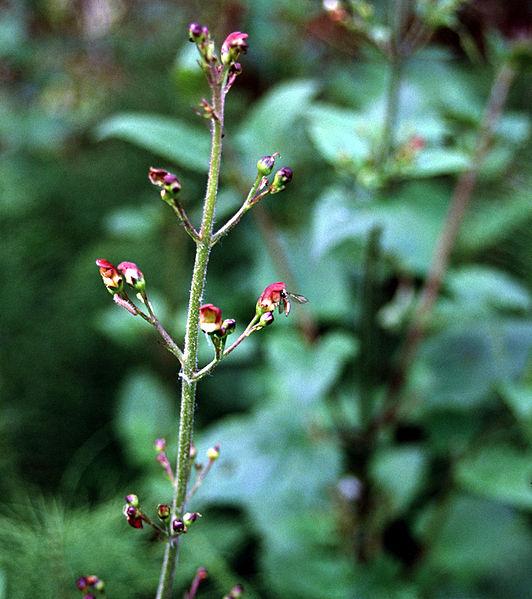
|
Sedum 'Autumn Joy'
Pronunciation
SEE-dum
Common Name
Stonecrop 'Autumn Joy'
Plant Type
Succulent
Mature Size
1 - 2 ft. high and 2 ft. wide
Water Requirements
Low: water every three weeks until the root ball is wet
Sun/Shade Requirements
Full to half sun
Wildlife
Flower Color
Pink
Where to See
Maintenance- Design- Planting Tips
Sedum 'Autumn Joy' stands upright with no need for extra support, needs very little water and generally is not bothered by garden insects. In late summer, strong pink flowers bloom and slowly fade to a rust color. This plant is good for adding color to the garden when most other plants are tired and resting. During the winter months 'Autumn Joy' dies back to the ground and returns in the early spring.
PADG Notes: In the demonstration garden, Sedum 'Autumn Joy' is planted in a very rocky, well drained spot. It has grown very slowly, but steadily. It is a favorite of many gardeners because of the long-lasting fall color. |
Sisyrinchium bellum
Pronunciation
si-si-RINK-ee-um BEL-lum
Common Name
Blue-Eyed Grass
Plant Type
Perennial
Mature Size
12 inches high x 6 inches - 2 feet wide
Water Requirements
Low: water every three weeks until the root ball is wet
Sun/Shade Requirements
Full to half sun
Wildlife
Flower Color
Blue
Where to See
Maintenance- Design- Planting Tips
This California native plant has green or bluish green strappy leaves. In early spring small blue flowers cover the plant. They are showiest when planted in masses. The clear-blue flowers are eye-catching in the spring garden. There are different cultivars that offer subtle variations.
PADG Notes: When Sisyrinchium bellum dies back with hot weather, the dried foliage is removed. With additional water throughout the summer, plants will stay evergreen and continue to occasionally rebloom. Some reseeding will occur, but not aggressively. |
Solidago velutina
Pronunciation
so-lid-AH-goh vel-ew-TEEN-uh
Common Name
Threenerve Goldenrod
Plant Type
Groundcover
Mature Size
0.7 - 3 ft (0.21 - 0.9 m) tall
Water Requirements
Low: water every three weeks until the root ball is wet
Sun/Shade Requirements
Full sun
Wildlife
Flower Color
Yellow
Where to See
Maintenance- Design- Planting Tips
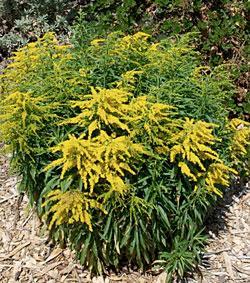
|
Solidago velutina ssp. californica
Pronunciation
so-lid-AH-goh vel-oo-TEE-nuh
Common Name
California Goldenrod
Plant Type
Groundcover
Mature Size
1.5 - 5 ft (0.46 - 1.5 m) tall
Water Requirements
Low: water every three weeks until the root ball is wet
Sun/Shade Requirements
Full to half sun
Wildlife
Flower Color
Yellow
Where to See
Maintenance- Design- Planting Tips
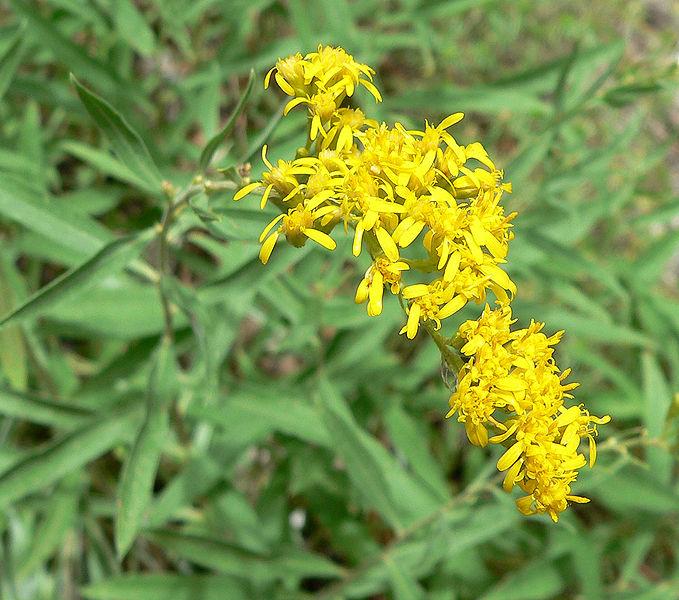
|
Stachys byzantina 'Countess Helen von Stein'
Pronunciation
STAKA-is bye-zan-TEEN-ah
Common Name
Lamb's Ears
Plant Type
Groundcover
Mature Size
3 ft. wide and 6 in. to 12 in. tall
Water Requirements
Low: water every three weeks until the root ball is wet
Sun/Shade Requirements
Full to half sun
Wildlife
Flower Color
Where to See
Maintenance- Design- Planting Tips
Not every plant in the garden has that "wow factor" going for it, and that's a good thing. Sometimes plants are needed to fill in bare spots and give the eye a rest. Lamb's ears are a classic filler plant for a water-wise garden.
"Helen von Stein' is a wonderful cultivar because it has extra-large leaves and doesn't bloom a lot. With its large leaves, it provides contrast to smaller leaved plants in the garden. After a couple years, these plants tend to spread and die out in the middle. Use a sharp shovel and divide the clumps in fall or early winter. Lamb's ears may also have some die back over the winter; we recommend leaving the dead leaves in place until all danger of frost has passed. PADG Notes: We have used Stachys and other silver-leaved plants to visually tie together the edges of our beds. Some gardeners love the dramatic flower spikes on lamb's ears, but we have mixed feelings. Sometimes we cut them off and sometimes we leave them in place.
|
Symphyotrichum chilense
Pronunciation
sim-fee-OT-ri-koom chi-LEN-see
Common Name
California Aster (Pacifc Aster)
Plant Type
Perennial
Mature Size
3 ft (0.9 m) wide x 1.3 - 3.3 ft. (0.4 - 1 m) tall
Water Requirements
Low: water every three weeks until the root ball is wet
Sun/Shade Requirements
Full to half sun
Wildlife
Flower Color
Blue, Lavender, Yellow
Where to See
Maintenance- Design- Planting Tips
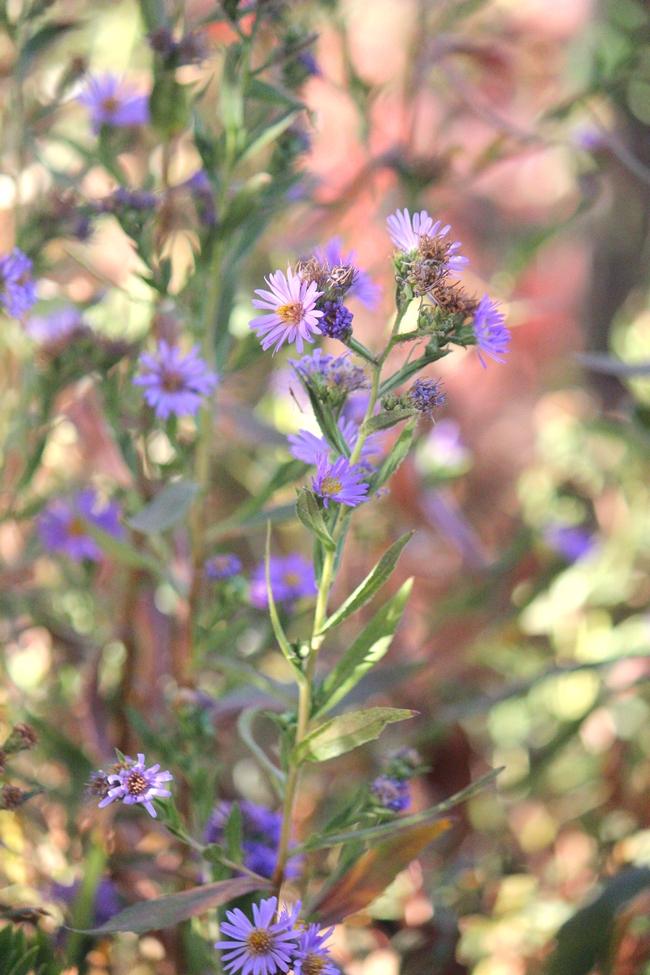
|
Tagetes lemmonii
Pronunciation
tah-JEE-deez lem-mon-ee-eye
Common Name
Mexican Bush Marigold
Plant Type
Perennial
Mature Size
4 ft. to 6 ft. wide and 3 ft. to 6 ft. tall
Water Requirements
Low: water every three weeks until the root ball is wet
Sun/Shade Requirements
Full to half sun
Wildlife
Flower Color
Where to See
Maintenance- Design- Planting Tips
Tagetes lemmonii is a sprawling shrub-like perennial with yellow flowers and aromatic leaves. The plant is originally from Mexico and the southwestern U.S.
PADG Notes: Mexican Bush Marigold can become large and ungainly, so we recommend shearing this plant several inches from the ground in the spring to keep the plant compact and give it a nice shape. Also, prune out any frost damage once the danger of frost is over. Tagetes lemmonii is not long-lived in the garden, but if you like yellow flowers and enjoy the smell of its leaves this plant is worth planting. In the demonstration garden we removed Tagetes lemmonii because it repeatedly suffered frost damage and was not attractive. |
Teucrium fruticans ‘Azureum’
Pronunciation
Tew-kree-um FREW-ti-kanz
Common Name
Bush Germander
Plant Type
Shrub
Mature Size
4 - 6 ft. tall and wide
Water Requirements
Low: water every three weeks until the root ball is wet
Sun/Shade Requirements
Full sun
Wildlife
Flower Color
Violet blue
Where to See
Maintenance- Design- Planting Tips
Teucium fruticans 'Azureum' has attractive blue flowers all winter long. The rest of the year it has a smaller floral display. The deep blue stands out against the grey foliage.
PADG Notes: A drawback to Bush Germander is it can grow to be very large. We pruned ours back to 4 inches to help control its size. The shrub came roaring back with a natural shape and a slightly smaller size. The winter blooms are plentiful. We recently planted a smaller Teucrium cultivar, 'Compactum' that is reputed to stay 3 feet tall and wide and have intense blue flowers. |
Thymus vulgaris
Pronunciation
TY-mus vul-GAR-iss
Common Name
Thyme
Plant Type
Groundcover
Mature Size
3 in. high and 3 ft. wide
Water Requirements
Low: water every three weeks until the root ball is wet
Sun/Shade Requirements
Full to half sun
Wildlife
Flower Color
Where to See
Maintenance- Design- Planting Tips
Many herbs, including thyme, are great additions to water wise gardens. They can be used in cooking; they smell great and their foliage and flowers are attractive.
Thyme makes a nice ground cover for small spaces. It has grey-green leaves and small white flowers. PADG Notes: To keep thyme neat, the faded flowers are sheared back in early spring. Many thymes are not long lived, but Thymus vulgaris has proven to be long-lived in our water wise garden. |
Verbena bonariensis
Pronunciation
ver-BEE-na bo-nar-ee-EN-sis
Common Name
Verbena
Plant Type
Perennial
Mature Size
3-6 ft tall x 1-3 ft wide
Water Requirements
Low: water every three weeks until the root ball is wet
Sun/Shade Requirements
Full sun
Wildlife
Flower Color
Purple
Where to See
Maintenance- Design- Planting Tips
Best used as a background plant, Verbena bonariensis does best in hot, dry locations with good air circulation and well-draining soil.
This is a fast-growing plant, which if happy in the garden, will spread by seed. It has a small clump of green leaves that produce tall flowering stems in the hot summer months. The overall look is light and airy. Tall stems should be cut down when flowers have faded. PADG Notes: This plant is no longer in the garden because it needed some supplemental water to keep it thriving. |
Watsonia
Pronunciation
wat-SON-ee-uh
Common Name
Watsonia
Plant Type
Bulb
Mature Size
2 1/2 ft. tall and wide
Water Requirements
Low: water every three weeks until the root ball is wet
Sun/Shade Requirements
Full sun
Wildlife
Flower Color
Pink, rosy red, white, lavender, peach, orange
Where to See
Maintenance- Design- Planting Tips
Watsonia is a South African plant that grows well in the Santa Clara Valley. The pink gladiolus-like flowers are a highlight of late spring gardens. The sword-shaped leaves provide strong accent points in beds. Some retail nurseries carry a selection of Watsonia corms (bulbs) in the fall.
PADG Notes: This is a summer dormant plant, which means it can get by on almost no water in the summer but has unattractive leaves starting in July. We solve the ugly leaf problem by cutting the leaves back to a couple inches above ground in mid-summer. This results in a bare spot in the bed. If that bothers you, install a plant next to the Watsonia that will fill in the bare spot during the summer and fall months. |
Westringia fruticosa 'Wynyabbie Gem"
Pronunciation
west-RING-ee-uh froo-tih-KOH-suh
Common Name
Coast Rosemary
Plant Type
Shrub
Mature Size
3 - 6 ft. tall and 5 - 10 ft. wide
Water Requirements
Low: water every three weeks until the root ball is wet
Sun/Shade Requirements
Full sun
Wildlife
Flower Color
White to light lavender
Where to See
Maintenance- Design- Planting Tips
This shrub from Australia looks a lot like rosemary, but its leaves are finer and have no fragrance. It has light lavender flowers that appear in midwinter and last through spring.
Westringia grow into large plants so plan ahead or be prepared for a lot of pruning. Unlike rosemary, the stems of Westringia do not get woody, which makes it is a better long term landscaping choice. |







